David Simon's Blog, page 10
March 22, 2018
The Donkey Jesus Rode
A story is told of a donkey born long ago in the province of Galilee. He was born on a farm with much rocky soil. One night a neighbor who had been ordered to travel several days distance in order to pay his taxes came to this farm. He wished to take his wife, who was near delivery of her child and would find it hard to walk, with him on this journey. The poor farmer lent the donkey to Joseph and his wife Mary for their well-known journey to Bethlehem.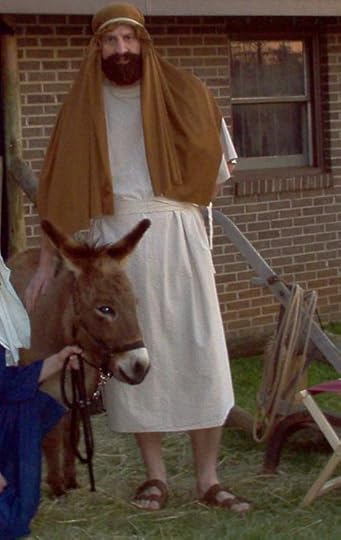 The Donkey Farmer from our production of
The Donkey Farmer from our production of
The Case of the Missing BodySoon after this journey to Bethlehem, the donkey carried the baby and his mother on another journey to a foreign land to escape the anger of Judea’s cruel king. This child, more than any other, was special to the donkey, who following this time would live a hard life.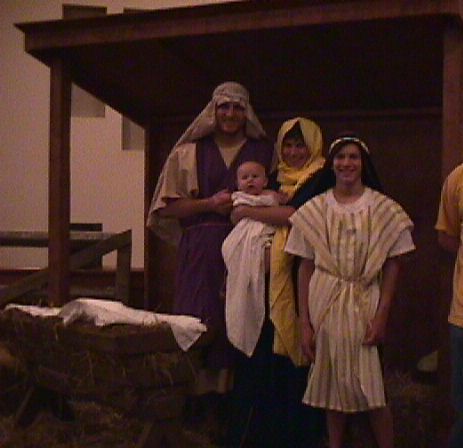 The Donkey watched as Jesus was bornThe donkey was sold to a caravan, and for years carried loads on journeys to far away places. When her feet gave out and she could not travel as far, she was sold to a farmer near a town she remembered as the birthplace of that special child. The donkey worked for the farmer plowing his fields and carrying his loads to the market … even to the market in the populous city of Jerusalem.
The Donkey watched as Jesus was bornThe donkey was sold to a caravan, and for years carried loads on journeys to far away places. When her feet gave out and she could not travel as far, she was sold to a farmer near a town she remembered as the birthplace of that special child. The donkey worked for the farmer plowing his fields and carrying his loads to the market … even to the market in the populous city of Jerusalem.
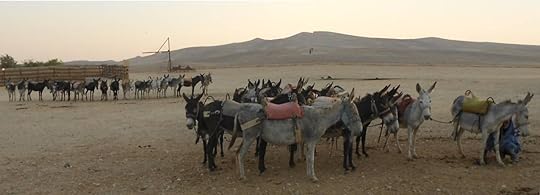 A Donkey Caravan in the DesertOne day in the market with a foal of her own, the donkey heard a voice, and remembered the baby she had met so long ago. She was led to this person, now a man who stooped and petted her mane. He said, “Never fear, little donkey, you have helped me once and you will help me again as we travel this road like a king.”
A Donkey Caravan in the DesertOne day in the market with a foal of her own, the donkey heard a voice, and remembered the baby she had met so long ago. She was led to this person, now a man who stooped and petted her mane. He said, “Never fear, little donkey, you have helped me once and you will help me again as we travel this road like a king.”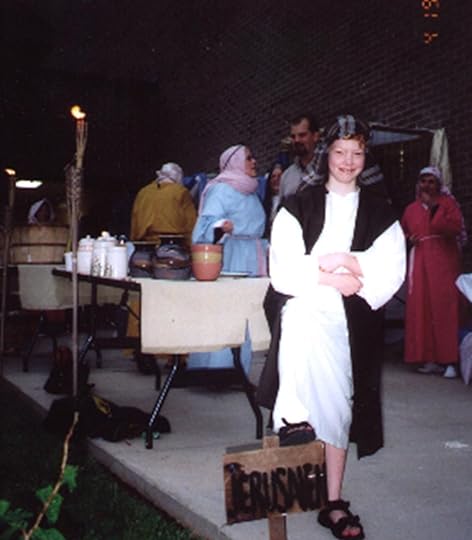 The Jerusalem Marketplace from our DramaThe road they traveled led to the city gates, where a crowd had gathered to sing praise to God. Palm branches and cloth cushioned the feet of the donkey, who thought her heart would burst with joy.
The Jerusalem Marketplace from our DramaThe road they traveled led to the city gates, where a crowd had gathered to sing praise to God. Palm branches and cloth cushioned the feet of the donkey, who thought her heart would burst with joy.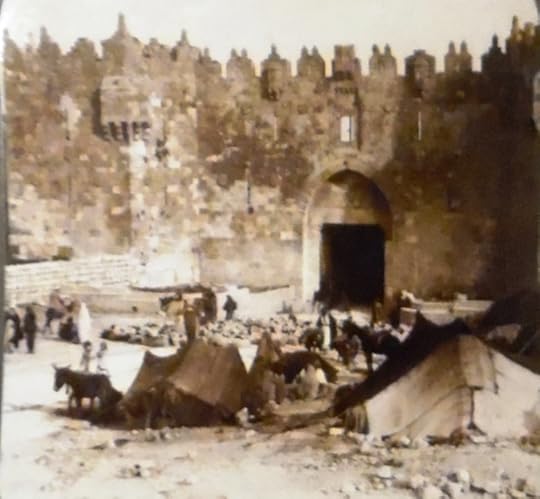 An old photo of the Damascus Gate in JerusalemA week went by, and the farmer’s work was done. He packed his boxes and a remaining load on the back of this donkey that had been so loyal and true. As they left the town, a sinister crowd formed and grew in number. They were jeering and hissing at three criminals, all bearing their own crosses on which they would be crucified for their crimes against God and man, so the world would be a better place to live.
An old photo of the Damascus Gate in JerusalemA week went by, and the farmer’s work was done. He packed his boxes and a remaining load on the back of this donkey that had been so loyal and true. As they left the town, a sinister crowd formed and grew in number. They were jeering and hissing at three criminals, all bearing their own crosses on which they would be crucified for their crimes against God and man, so the world would be a better place to live.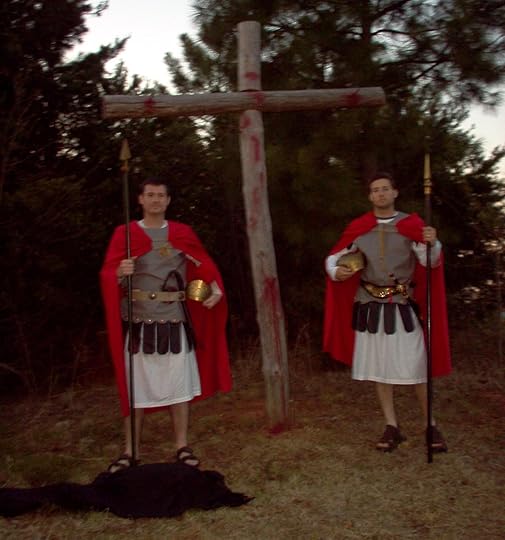 Roman Soldiers at the CrossBut one of the three did not fit the scene. His face was serene and pure. The donkey knew the man because of His purity. This was the baby she had carried into Egypt. And this was the man whom but a week before had ridden this donkey into Jerusalem amid a joyful crowd. But this day was so dark. The donkey knew she couldn’t help him on this day, for his load was to be borne alone. But a shadow fell on the back of the donkey that day; the shadow of the cross which this man carried. And the shadow stuck and will be seen today on all donkeys you see (and those you don’t) – to remember the life of this well-known man who carried the greatest load of all time.
Roman Soldiers at the CrossBut one of the three did not fit the scene. His face was serene and pure. The donkey knew the man because of His purity. This was the baby she had carried into Egypt. And this was the man whom but a week before had ridden this donkey into Jerusalem amid a joyful crowd. But this day was so dark. The donkey knew she couldn’t help him on this day, for his load was to be borne alone. But a shadow fell on the back of the donkey that day; the shadow of the cross which this man carried. And the shadow stuck and will be seen today on all donkeys you see (and those you don’t) – to remember the life of this well-known man who carried the greatest load of all time.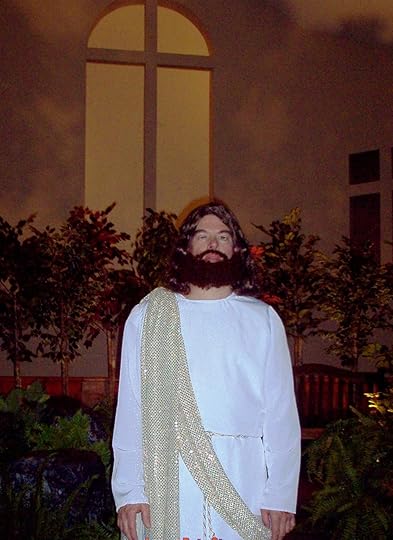 The Audience meets Jesus in
The Audience meets Jesus in
The Case of the Missing bodyThe man with the cross is Jesus Christ, who came to forgive all our sins. He bore the load for all who accept and receive Him as Savior and Lord.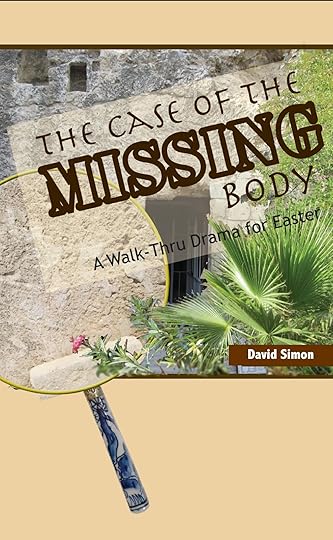 The Case of the Missing Body is a great read for EasterThis story is an excerpt from the book
The Case of the Missing Body: A Walk-Thru Drama for Easter
. The book contains an Easter drama, and much more. There is Biblical information about each person in the scenes of this play (including the Donkey) and there are stories to help the cast get into character (like the one in this blog). Well worth the one dollar cost on Amazon.com
The Case of the Missing Body is a great read for EasterThis story is an excerpt from the book
The Case of the Missing Body: A Walk-Thru Drama for Easter
. The book contains an Easter drama, and much more. There is Biblical information about each person in the scenes of this play (including the Donkey) and there are stories to help the cast get into character (like the one in this blog). Well worth the one dollar cost on Amazon.com
 These books are available at Amazon.comI have produced several other books with stories from Bible times including
Israel: Stories for Your Journey
(more than 250 stories written to help tourists understand Israel, but interesting reading for anyone);
Spring: Connecting With God
(a book about how Passover has been celebrated through the years. The chapter on Jesus contains stories from four of the Passovers he observed as written about in the Gospels);
A Christian Passover in the Jewish Tradition
(a home Passover observance with a full explanation of each part and leader instructions);
Advent Journeys
(What Joseph, Zacharias, the Shepherds, the Magi and the Maccabees would have blogged during their journeys to Bethlehem and beyond). If you enjoy stories you can read these books on Amazon Prime for free or purchase them on Kindle or in print.
These books are available at Amazon.comI have produced several other books with stories from Bible times including
Israel: Stories for Your Journey
(more than 250 stories written to help tourists understand Israel, but interesting reading for anyone);
Spring: Connecting With God
(a book about how Passover has been celebrated through the years. The chapter on Jesus contains stories from four of the Passovers he observed as written about in the Gospels);
A Christian Passover in the Jewish Tradition
(a home Passover observance with a full explanation of each part and leader instructions);
Advent Journeys
(What Joseph, Zacharias, the Shepherds, the Magi and the Maccabees would have blogged during their journeys to Bethlehem and beyond). If you enjoy stories you can read these books on Amazon Prime for free or purchase them on Kindle or in print.
 The Donkey Farmer from our production of
The Donkey Farmer from our production ofThe Case of the Missing BodySoon after this journey to Bethlehem, the donkey carried the baby and his mother on another journey to a foreign land to escape the anger of Judea’s cruel king. This child, more than any other, was special to the donkey, who following this time would live a hard life.
 The Donkey watched as Jesus was bornThe donkey was sold to a caravan, and for years carried loads on journeys to far away places. When her feet gave out and she could not travel as far, she was sold to a farmer near a town she remembered as the birthplace of that special child. The donkey worked for the farmer plowing his fields and carrying his loads to the market … even to the market in the populous city of Jerusalem.
The Donkey watched as Jesus was bornThe donkey was sold to a caravan, and for years carried loads on journeys to far away places. When her feet gave out and she could not travel as far, she was sold to a farmer near a town she remembered as the birthplace of that special child. The donkey worked for the farmer plowing his fields and carrying his loads to the market … even to the market in the populous city of Jerusalem. A Donkey Caravan in the DesertOne day in the market with a foal of her own, the donkey heard a voice, and remembered the baby she had met so long ago. She was led to this person, now a man who stooped and petted her mane. He said, “Never fear, little donkey, you have helped me once and you will help me again as we travel this road like a king.”
A Donkey Caravan in the DesertOne day in the market with a foal of her own, the donkey heard a voice, and remembered the baby she had met so long ago. She was led to this person, now a man who stooped and petted her mane. He said, “Never fear, little donkey, you have helped me once and you will help me again as we travel this road like a king.” The Jerusalem Marketplace from our DramaThe road they traveled led to the city gates, where a crowd had gathered to sing praise to God. Palm branches and cloth cushioned the feet of the donkey, who thought her heart would burst with joy.
The Jerusalem Marketplace from our DramaThe road they traveled led to the city gates, where a crowd had gathered to sing praise to God. Palm branches and cloth cushioned the feet of the donkey, who thought her heart would burst with joy. An old photo of the Damascus Gate in JerusalemA week went by, and the farmer’s work was done. He packed his boxes and a remaining load on the back of this donkey that had been so loyal and true. As they left the town, a sinister crowd formed and grew in number. They were jeering and hissing at three criminals, all bearing their own crosses on which they would be crucified for their crimes against God and man, so the world would be a better place to live.
An old photo of the Damascus Gate in JerusalemA week went by, and the farmer’s work was done. He packed his boxes and a remaining load on the back of this donkey that had been so loyal and true. As they left the town, a sinister crowd formed and grew in number. They were jeering and hissing at three criminals, all bearing their own crosses on which they would be crucified for their crimes against God and man, so the world would be a better place to live. Roman Soldiers at the CrossBut one of the three did not fit the scene. His face was serene and pure. The donkey knew the man because of His purity. This was the baby she had carried into Egypt. And this was the man whom but a week before had ridden this donkey into Jerusalem amid a joyful crowd. But this day was so dark. The donkey knew she couldn’t help him on this day, for his load was to be borne alone. But a shadow fell on the back of the donkey that day; the shadow of the cross which this man carried. And the shadow stuck and will be seen today on all donkeys you see (and those you don’t) – to remember the life of this well-known man who carried the greatest load of all time.
Roman Soldiers at the CrossBut one of the three did not fit the scene. His face was serene and pure. The donkey knew the man because of His purity. This was the baby she had carried into Egypt. And this was the man whom but a week before had ridden this donkey into Jerusalem amid a joyful crowd. But this day was so dark. The donkey knew she couldn’t help him on this day, for his load was to be borne alone. But a shadow fell on the back of the donkey that day; the shadow of the cross which this man carried. And the shadow stuck and will be seen today on all donkeys you see (and those you don’t) – to remember the life of this well-known man who carried the greatest load of all time. The Audience meets Jesus in
The Audience meets Jesus inThe Case of the Missing bodyThe man with the cross is Jesus Christ, who came to forgive all our sins. He bore the load for all who accept and receive Him as Savior and Lord.
 The Case of the Missing Body is a great read for EasterThis story is an excerpt from the book
The Case of the Missing Body: A Walk-Thru Drama for Easter
. The book contains an Easter drama, and much more. There is Biblical information about each person in the scenes of this play (including the Donkey) and there are stories to help the cast get into character (like the one in this blog). Well worth the one dollar cost on Amazon.com
The Case of the Missing Body is a great read for EasterThis story is an excerpt from the book
The Case of the Missing Body: A Walk-Thru Drama for Easter
. The book contains an Easter drama, and much more. There is Biblical information about each person in the scenes of this play (including the Donkey) and there are stories to help the cast get into character (like the one in this blog). Well worth the one dollar cost on Amazon.com These books are available at Amazon.comI have produced several other books with stories from Bible times including
Israel: Stories for Your Journey
(more than 250 stories written to help tourists understand Israel, but interesting reading for anyone);
Spring: Connecting With God
(a book about how Passover has been celebrated through the years. The chapter on Jesus contains stories from four of the Passovers he observed as written about in the Gospels);
A Christian Passover in the Jewish Tradition
(a home Passover observance with a full explanation of each part and leader instructions);
Advent Journeys
(What Joseph, Zacharias, the Shepherds, the Magi and the Maccabees would have blogged during their journeys to Bethlehem and beyond). If you enjoy stories you can read these books on Amazon Prime for free or purchase them on Kindle or in print.
These books are available at Amazon.comI have produced several other books with stories from Bible times including
Israel: Stories for Your Journey
(more than 250 stories written to help tourists understand Israel, but interesting reading for anyone);
Spring: Connecting With God
(a book about how Passover has been celebrated through the years. The chapter on Jesus contains stories from four of the Passovers he observed as written about in the Gospels);
A Christian Passover in the Jewish Tradition
(a home Passover observance with a full explanation of each part and leader instructions);
Advent Journeys
(What Joseph, Zacharias, the Shepherds, the Magi and the Maccabees would have blogged during their journeys to Bethlehem and beyond). If you enjoy stories you can read these books on Amazon Prime for free or purchase them on Kindle or in print.
Published on March 22, 2018 23:30
March 21, 2018
The Gate into Jerusalem
The Lord said to me, “This gate is to remain shut. It must not be opened; no one may enter through it. It is to remain shut because the Lord, the God of Israel, has entered through it. The prince himself is the only one who may sit inside the gateway to eat in the presence of the Lord. He is to enter by way of the portico of the gateway and go out the same way.” (Ezekiel 44:1-3)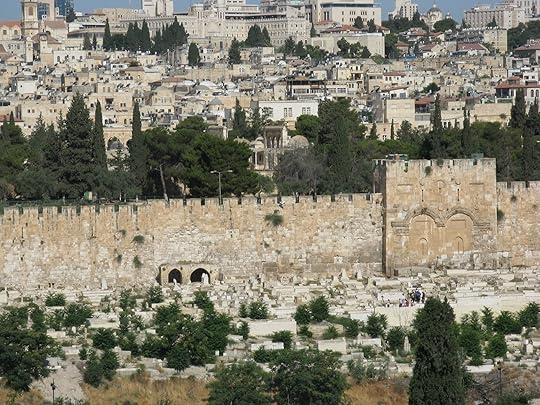 The Golden Gate into JerusalemOriginally the gate was built during the reign of King Solomon. It was placed to the east of the new Temple because the sole entrance for the Tabernacle was placed on the east, in the direction of the rising sun. The priests used the gate to send the scapegoat away from the Temple and to take the Red Heifer to the Mount of Olives. After the first Temple was destroyed, Ezekiel said the Messiah would eventually enter through this gate.
The Golden Gate into JerusalemOriginally the gate was built during the reign of King Solomon. It was placed to the east of the new Temple because the sole entrance for the Tabernacle was placed on the east, in the direction of the rising sun. The priests used the gate to send the scapegoat away from the Temple and to take the Red Heifer to the Mount of Olives. After the first Temple was destroyed, Ezekiel said the Messiah would eventually enter through this gate.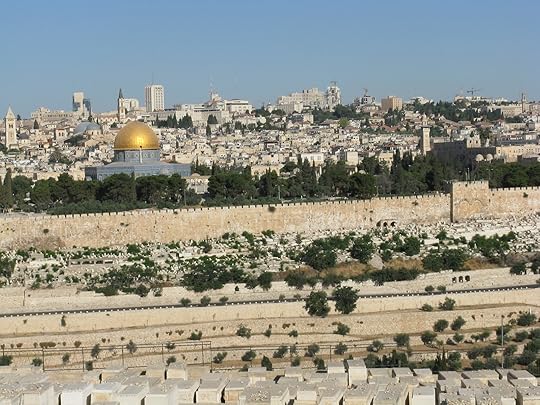 The Golden Gate and the Dome of the RockIn about the year 30 AD, Mark tells us, “Many people spread their cloaks on the road, while others spread branches they had cut in the fields. Those who went ahead and those who followed shouted, ‘Hosanna! Blessed is he who comes in the name of the Lord! Blessed is the coming kingdom of our father David! Hosanna in the highest heaven’ Jesus entered Jerusalem and went into the temple courts.” (11:8-11)
The Golden Gate and the Dome of the RockIn about the year 30 AD, Mark tells us, “Many people spread their cloaks on the road, while others spread branches they had cut in the fields. Those who went ahead and those who followed shouted, ‘Hosanna! Blessed is he who comes in the name of the Lord! Blessed is the coming kingdom of our father David! Hosanna in the highest heaven’ Jesus entered Jerusalem and went into the temple courts.” (11:8-11)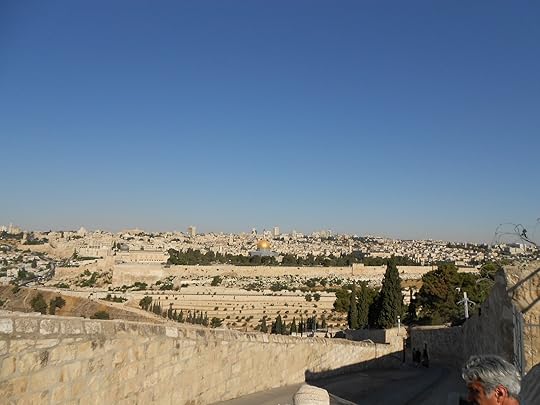 The road from Mount of Olives to JerusalemThe Messiah entered the gate on a donkey according to the prophecies of Genesis 49:11, Psalm 118:22-29; Ezekiel 46:12; and Zechariah 9:9. He spent the week teaching in the Temple, and then he gave the gift of life, according to the prophecies, on the cross. Jesus was buried in the tomb for three days. Then he arose from the dead, walked among his disciples for forty days, and ascended to heaven east of the Temple and its Golden Gate, on the Mount of Olives.
The road from Mount of Olives to JerusalemThe Messiah entered the gate on a donkey according to the prophecies of Genesis 49:11, Psalm 118:22-29; Ezekiel 46:12; and Zechariah 9:9. He spent the week teaching in the Temple, and then he gave the gift of life, according to the prophecies, on the cross. Jesus was buried in the tomb for three days. Then he arose from the dead, walked among his disciples for forty days, and ascended to heaven east of the Temple and its Golden Gate, on the Mount of Olives.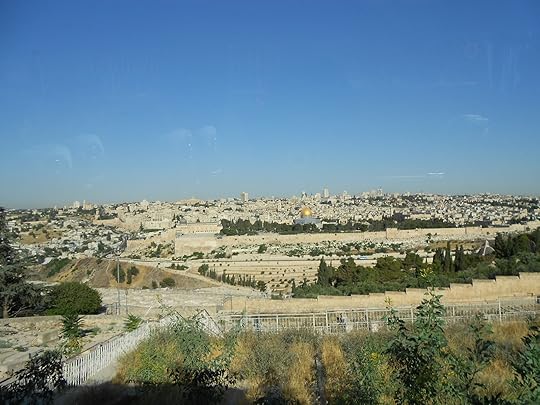 A bird's eye view of Jerusalem from the Mount of OlivesIt is believed that Jesus will enter Jerusalem through the Golden Gate when He returns in what is called the second coming. This is because when the Spirit left the Temple in Jerusalem after Nebuchadnezzar deported Israel, the Spirit flew above the Golden Gate and over the Mount of Olives.
A bird's eye view of Jerusalem from the Mount of OlivesIt is believed that Jesus will enter Jerusalem through the Golden Gate when He returns in what is called the second coming. This is because when the Spirit left the Temple in Jerusalem after Nebuchadnezzar deported Israel, the Spirit flew above the Golden Gate and over the Mount of Olives.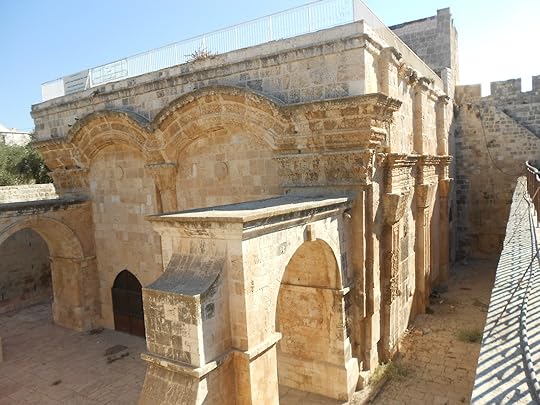 An inside view of the Golden Gate“Then the cherubim, with the wheels beside them, spread their wings, and the glory of the God of Israel was above them. The glory of the Lord went up from within the city and stopped above the mountain east of it. The Spirit lifted me up and brought me to the exiles in Babylonia in the vision given by the Spirit of God.” (Ezekiel 11:22-24)
An inside view of the Golden Gate“Then the cherubim, with the wheels beside them, spread their wings, and the glory of the God of Israel was above them. The glory of the Lord went up from within the city and stopped above the mountain east of it. The Spirit lifted me up and brought me to the exiles in Babylonia in the vision given by the Spirit of God.” (Ezekiel 11:22-24)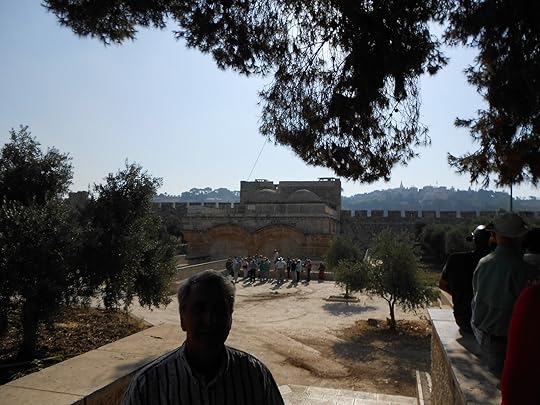 Looking from Temple Mount past the Golden Gate to OlivetI have written much more about the Golden Gate and its stories in a kindle book -
Israel: Stories for Your Journey
. This $2 book is an excellent resource for anyone traveling to Israel. It goes beyond the normal guide books to tell over 250 stories about the sites most tourists visit.
Looking from Temple Mount past the Golden Gate to OlivetI have written much more about the Golden Gate and its stories in a kindle book -
Israel: Stories for Your Journey
. This $2 book is an excellent resource for anyone traveling to Israel. It goes beyond the normal guide books to tell over 250 stories about the sites most tourists visit.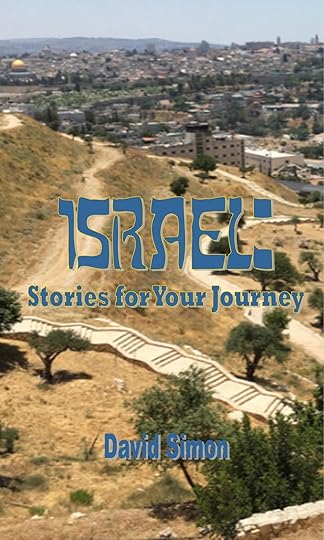 An excellent guide book for travelers to Israel
An excellent guide book for travelers to Israel
I learned a lot about the land of the Bible through three visits and by writing Israel: Stories for Your Journey (1.99 on Kindle), Many questions and ideas I formed about stories in the Bible were answered through seeing and studying the geography of the land. I invite you to visit Israel or read my book to learn more.
 The Golden Gate into JerusalemOriginally the gate was built during the reign of King Solomon. It was placed to the east of the new Temple because the sole entrance for the Tabernacle was placed on the east, in the direction of the rising sun. The priests used the gate to send the scapegoat away from the Temple and to take the Red Heifer to the Mount of Olives. After the first Temple was destroyed, Ezekiel said the Messiah would eventually enter through this gate.
The Golden Gate into JerusalemOriginally the gate was built during the reign of King Solomon. It was placed to the east of the new Temple because the sole entrance for the Tabernacle was placed on the east, in the direction of the rising sun. The priests used the gate to send the scapegoat away from the Temple and to take the Red Heifer to the Mount of Olives. After the first Temple was destroyed, Ezekiel said the Messiah would eventually enter through this gate. The Golden Gate and the Dome of the RockIn about the year 30 AD, Mark tells us, “Many people spread their cloaks on the road, while others spread branches they had cut in the fields. Those who went ahead and those who followed shouted, ‘Hosanna! Blessed is he who comes in the name of the Lord! Blessed is the coming kingdom of our father David! Hosanna in the highest heaven’ Jesus entered Jerusalem and went into the temple courts.” (11:8-11)
The Golden Gate and the Dome of the RockIn about the year 30 AD, Mark tells us, “Many people spread their cloaks on the road, while others spread branches they had cut in the fields. Those who went ahead and those who followed shouted, ‘Hosanna! Blessed is he who comes in the name of the Lord! Blessed is the coming kingdom of our father David! Hosanna in the highest heaven’ Jesus entered Jerusalem and went into the temple courts.” (11:8-11) The road from Mount of Olives to JerusalemThe Messiah entered the gate on a donkey according to the prophecies of Genesis 49:11, Psalm 118:22-29; Ezekiel 46:12; and Zechariah 9:9. He spent the week teaching in the Temple, and then he gave the gift of life, according to the prophecies, on the cross. Jesus was buried in the tomb for three days. Then he arose from the dead, walked among his disciples for forty days, and ascended to heaven east of the Temple and its Golden Gate, on the Mount of Olives.
The road from Mount of Olives to JerusalemThe Messiah entered the gate on a donkey according to the prophecies of Genesis 49:11, Psalm 118:22-29; Ezekiel 46:12; and Zechariah 9:9. He spent the week teaching in the Temple, and then he gave the gift of life, according to the prophecies, on the cross. Jesus was buried in the tomb for three days. Then he arose from the dead, walked among his disciples for forty days, and ascended to heaven east of the Temple and its Golden Gate, on the Mount of Olives. A bird's eye view of Jerusalem from the Mount of OlivesIt is believed that Jesus will enter Jerusalem through the Golden Gate when He returns in what is called the second coming. This is because when the Spirit left the Temple in Jerusalem after Nebuchadnezzar deported Israel, the Spirit flew above the Golden Gate and over the Mount of Olives.
A bird's eye view of Jerusalem from the Mount of OlivesIt is believed that Jesus will enter Jerusalem through the Golden Gate when He returns in what is called the second coming. This is because when the Spirit left the Temple in Jerusalem after Nebuchadnezzar deported Israel, the Spirit flew above the Golden Gate and over the Mount of Olives. An inside view of the Golden Gate“Then the cherubim, with the wheels beside them, spread their wings, and the glory of the God of Israel was above them. The glory of the Lord went up from within the city and stopped above the mountain east of it. The Spirit lifted me up and brought me to the exiles in Babylonia in the vision given by the Spirit of God.” (Ezekiel 11:22-24)
An inside view of the Golden Gate“Then the cherubim, with the wheels beside them, spread their wings, and the glory of the God of Israel was above them. The glory of the Lord went up from within the city and stopped above the mountain east of it. The Spirit lifted me up and brought me to the exiles in Babylonia in the vision given by the Spirit of God.” (Ezekiel 11:22-24) Looking from Temple Mount past the Golden Gate to OlivetI have written much more about the Golden Gate and its stories in a kindle book -
Israel: Stories for Your Journey
. This $2 book is an excellent resource for anyone traveling to Israel. It goes beyond the normal guide books to tell over 250 stories about the sites most tourists visit.
Looking from Temple Mount past the Golden Gate to OlivetI have written much more about the Golden Gate and its stories in a kindle book -
Israel: Stories for Your Journey
. This $2 book is an excellent resource for anyone traveling to Israel. It goes beyond the normal guide books to tell over 250 stories about the sites most tourists visit. An excellent guide book for travelers to Israel
An excellent guide book for travelers to IsraelI learned a lot about the land of the Bible through three visits and by writing Israel: Stories for Your Journey (1.99 on Kindle), Many questions and ideas I formed about stories in the Bible were answered through seeing and studying the geography of the land. I invite you to visit Israel or read my book to learn more.
Published on March 21, 2018 03:30
March 8, 2018
St. Marks Church, the place of the Upper Room
Peter “went to the house of Mary, the mother of John whose other name was Mark, where many were gathered together and were praying.” Acts 12:12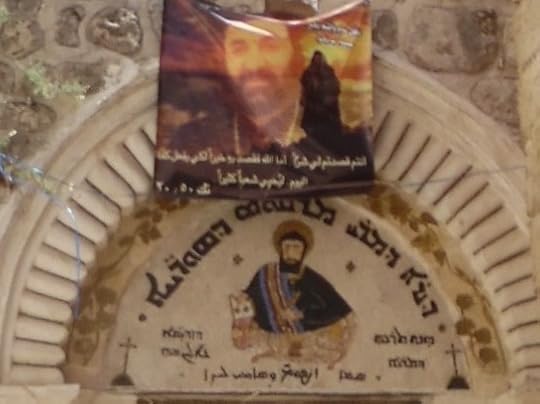 The entrance to Saint Mark's Syrian Orthodox MonistaryThe woman in black said that the church was old and said the church held records that proved the congregation existed in the first century, AD. From what she told us, this is the oldest church in all of Christianity. It is called Saint Mark's Syrian Orthodox Church and was built on the site where Jesus held his last supper, where the disciples met when they were in hiding, and where the early church met from its formation. If what the woman told us is true, this is the place where the Holy Spirit descended on the day of Pentecost and the successor was chosen for Judas Iscariot.
The entrance to Saint Mark's Syrian Orthodox MonistaryThe woman in black said that the church was old and said the church held records that proved the congregation existed in the first century, AD. From what she told us, this is the oldest church in all of Christianity. It is called Saint Mark's Syrian Orthodox Church and was built on the site where Jesus held his last supper, where the disciples met when they were in hiding, and where the early church met from its formation. If what the woman told us is true, this is the place where the Holy Spirit descended on the day of Pentecost and the successor was chosen for Judas Iscariot.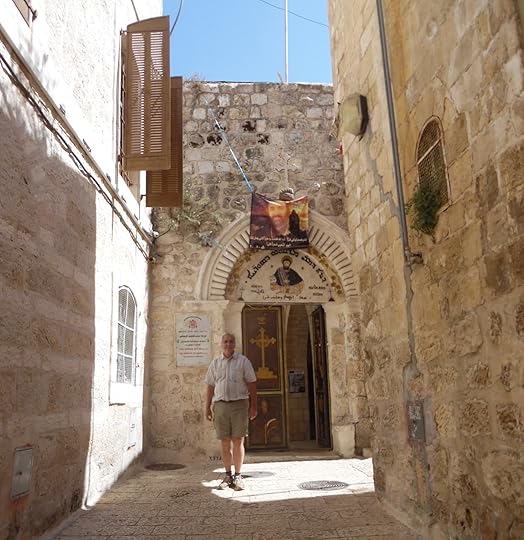 Where Ararat Street meets St. Mark's StreetThe building is on a hidden, out of the way street called Ararat. It is not particularly noticeable but historically, it is in the right location for the early church in old Jerusalem. It is not too far from the Temple Mount, near the route that the priests would have passed as they walked across the bridge from the upper class Upper Jerusalem residences to the Temple Mount. But the building is not on the Upper Bridge it's in the Tyropoeon Valley which is between the Temple Mount and the upper city.
Where Ararat Street meets St. Mark's StreetThe building is on a hidden, out of the way street called Ararat. It is not particularly noticeable but historically, it is in the right location for the early church in old Jerusalem. It is not too far from the Temple Mount, near the route that the priests would have passed as they walked across the bridge from the upper class Upper Jerusalem residences to the Temple Mount. But the building is not on the Upper Bridge it's in the Tyropoeon Valley which is between the Temple Mount and the upper city. 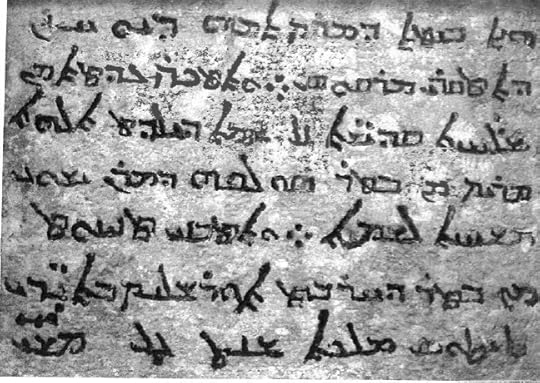 The ancient inscription, discovered in 1940As the woman took us on a tour of the sanctuary, we were told about an inscription which reads, “This is the house of Mary, mother of John, called Mark. Proclaimed a church by the holy apostles under the name of the Virgin Mary, mother of God, after the ascension of our Lord Jesus Christ into heaven. Renewed after the destruction of Jerusalem by Titus in the year A.D. 73.” Some doubt its authenticity for several reasons. She also showed us a portrait of Mary the mother of Jesus painted by Saint Luke on a ancient piece of leather.
The ancient inscription, discovered in 1940As the woman took us on a tour of the sanctuary, we were told about an inscription which reads, “This is the house of Mary, mother of John, called Mark. Proclaimed a church by the holy apostles under the name of the Virgin Mary, mother of God, after the ascension of our Lord Jesus Christ into heaven. Renewed after the destruction of Jerusalem by Titus in the year A.D. 73.” Some doubt its authenticity for several reasons. She also showed us a portrait of Mary the mother of Jesus painted by Saint Luke on a ancient piece of leather.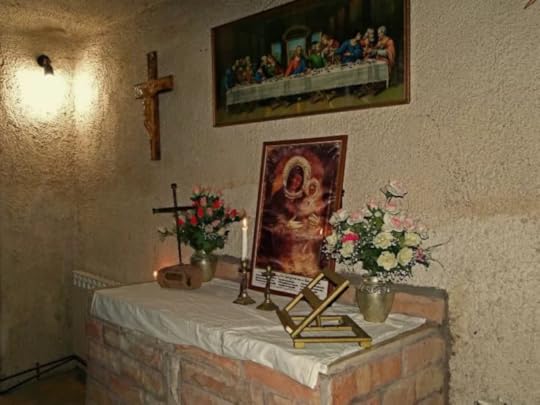 The painting by St. Luke on leatherThe ancient church itself is not visible by the general public, for it would be buried under rubble from the destruction which took place in the days of Titus, when Temple Mount was pushed over and all of Jerusalem was destroyed. The lady in black said that the upper room still existed there but it was 30 to 60 feet below the level of the ground and no one could go there. The closest people can get is the basement of the church that exists today.
The painting by St. Luke on leatherThe ancient church itself is not visible by the general public, for it would be buried under rubble from the destruction which took place in the days of Titus, when Temple Mount was pushed over and all of Jerusalem was destroyed. The lady in black said that the upper room still existed there but it was 30 to 60 feet below the level of the ground and no one could go there. The closest people can get is the basement of the church that exists today.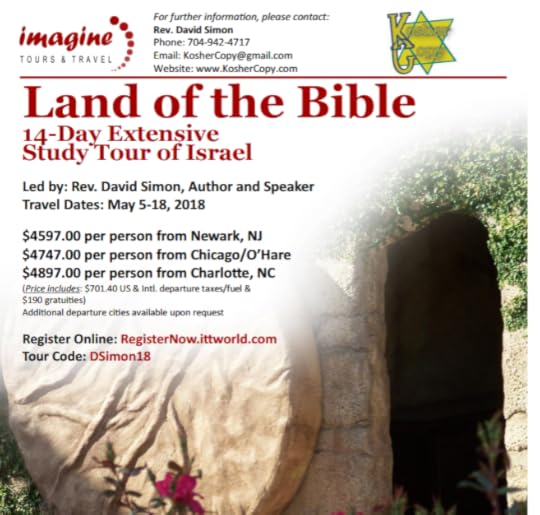 A travel brochure, more at www.KosherCopy.com
A travel brochure, more at www.KosherCopy.com
In about two months we will visit Jerusalem and walk by the ancient church. If you would like to travel with us, view more information on this website (link). If you would like to read the story behind ancient sites in Israel and Jerusalem, read the book, Israel: Stories for Your Journey . Much more information about the upper room can be found in this new book - The Case of the Missing Body: A Walk-Thru Drama for Easter
 The entrance to Saint Mark's Syrian Orthodox MonistaryThe woman in black said that the church was old and said the church held records that proved the congregation existed in the first century, AD. From what she told us, this is the oldest church in all of Christianity. It is called Saint Mark's Syrian Orthodox Church and was built on the site where Jesus held his last supper, where the disciples met when they were in hiding, and where the early church met from its formation. If what the woman told us is true, this is the place where the Holy Spirit descended on the day of Pentecost and the successor was chosen for Judas Iscariot.
The entrance to Saint Mark's Syrian Orthodox MonistaryThe woman in black said that the church was old and said the church held records that proved the congregation existed in the first century, AD. From what she told us, this is the oldest church in all of Christianity. It is called Saint Mark's Syrian Orthodox Church and was built on the site where Jesus held his last supper, where the disciples met when they were in hiding, and where the early church met from its formation. If what the woman told us is true, this is the place where the Holy Spirit descended on the day of Pentecost and the successor was chosen for Judas Iscariot. Where Ararat Street meets St. Mark's StreetThe building is on a hidden, out of the way street called Ararat. It is not particularly noticeable but historically, it is in the right location for the early church in old Jerusalem. It is not too far from the Temple Mount, near the route that the priests would have passed as they walked across the bridge from the upper class Upper Jerusalem residences to the Temple Mount. But the building is not on the Upper Bridge it's in the Tyropoeon Valley which is between the Temple Mount and the upper city.
Where Ararat Street meets St. Mark's StreetThe building is on a hidden, out of the way street called Ararat. It is not particularly noticeable but historically, it is in the right location for the early church in old Jerusalem. It is not too far from the Temple Mount, near the route that the priests would have passed as they walked across the bridge from the upper class Upper Jerusalem residences to the Temple Mount. But the building is not on the Upper Bridge it's in the Tyropoeon Valley which is between the Temple Mount and the upper city.  The ancient inscription, discovered in 1940As the woman took us on a tour of the sanctuary, we were told about an inscription which reads, “This is the house of Mary, mother of John, called Mark. Proclaimed a church by the holy apostles under the name of the Virgin Mary, mother of God, after the ascension of our Lord Jesus Christ into heaven. Renewed after the destruction of Jerusalem by Titus in the year A.D. 73.” Some doubt its authenticity for several reasons. She also showed us a portrait of Mary the mother of Jesus painted by Saint Luke on a ancient piece of leather.
The ancient inscription, discovered in 1940As the woman took us on a tour of the sanctuary, we were told about an inscription which reads, “This is the house of Mary, mother of John, called Mark. Proclaimed a church by the holy apostles under the name of the Virgin Mary, mother of God, after the ascension of our Lord Jesus Christ into heaven. Renewed after the destruction of Jerusalem by Titus in the year A.D. 73.” Some doubt its authenticity for several reasons. She also showed us a portrait of Mary the mother of Jesus painted by Saint Luke on a ancient piece of leather. The painting by St. Luke on leatherThe ancient church itself is not visible by the general public, for it would be buried under rubble from the destruction which took place in the days of Titus, when Temple Mount was pushed over and all of Jerusalem was destroyed. The lady in black said that the upper room still existed there but it was 30 to 60 feet below the level of the ground and no one could go there. The closest people can get is the basement of the church that exists today.
The painting by St. Luke on leatherThe ancient church itself is not visible by the general public, for it would be buried under rubble from the destruction which took place in the days of Titus, when Temple Mount was pushed over and all of Jerusalem was destroyed. The lady in black said that the upper room still existed there but it was 30 to 60 feet below the level of the ground and no one could go there. The closest people can get is the basement of the church that exists today. A travel brochure, more at www.KosherCopy.com
A travel brochure, more at www.KosherCopy.comIn about two months we will visit Jerusalem and walk by the ancient church. If you would like to travel with us, view more information on this website (link). If you would like to read the story behind ancient sites in Israel and Jerusalem, read the book, Israel: Stories for Your Journey . Much more information about the upper room can be found in this new book - The Case of the Missing Body: A Walk-Thru Drama for Easter
Published on March 08, 2018 23:30
March 5, 2018
Two Fish and Five Loaves
After this Jesus went away to the other side of the Sea of Galilee, which is the Sea of Tiberias. And a large crowd was following him, because they saw the signs that he was doing on the sick. (John 6:1-2)
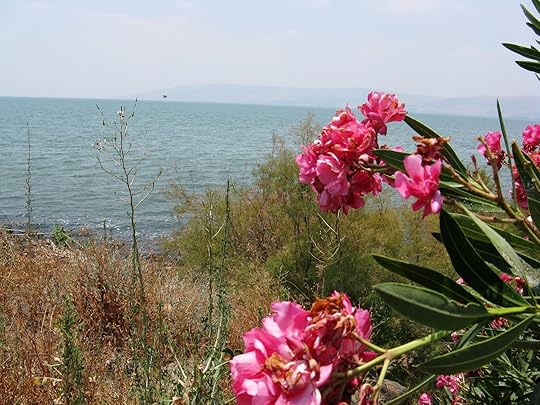 View of the Sea of Galilee from CapernaumThe second year of Jesus’ ministry is called “the year of popularity.” People were responding to His miracles and desired to hear His teachings. During Passover, people received word that Jesus was in the area and gathered to hear him near Tagba, on the shore of the Sea of Galilee. Tagba is a very fertile area where the fish are especially thick in the sea because seven warm springs release mineral rich water the area. (Read more about the area in Israel: Stories for Your Journey)
View of the Sea of Galilee from CapernaumThe second year of Jesus’ ministry is called “the year of popularity.” People were responding to His miracles and desired to hear His teachings. During Passover, people received word that Jesus was in the area and gathered to hear him near Tagba, on the shore of the Sea of Galilee. Tagba is a very fertile area where the fish are especially thick in the sea because seven warm springs release mineral rich water the area. (Read more about the area in Israel: Stories for Your Journey)
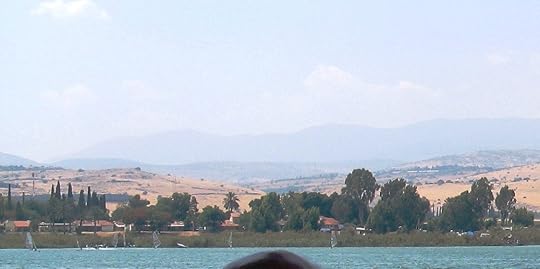 View of the north shore of the Sea of Galilee near TagbaPeople gathered into a natural amphitheater near the warm springs in especially large numbers in order to listen to Jesus. The conservative count of the people who attended this teaching session was 5000 men, plus women and children. The crowd came from Capernaum, Bethsaida, Magdala, and other villages along the northern shore of the Sea of Galilee. There were also people from Gadara, Hippos and the eastern side of the sea.
View of the north shore of the Sea of Galilee near TagbaPeople gathered into a natural amphitheater near the warm springs in especially large numbers in order to listen to Jesus. The conservative count of the people who attended this teaching session was 5000 men, plus women and children. The crowd came from Capernaum, Bethsaida, Magdala, and other villages along the northern shore of the Sea of Galilee. There were also people from Gadara, Hippos and the eastern side of the sea.
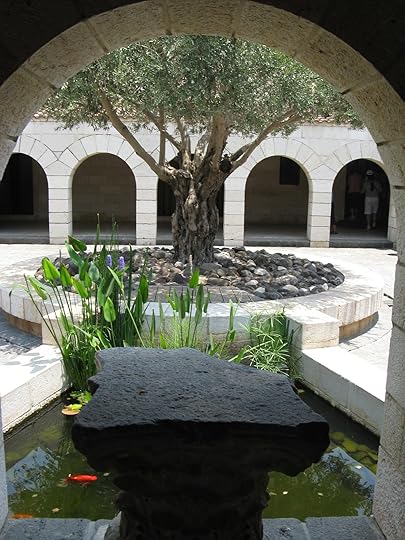 A pond in the chapel at TaagbaThe multitude of people listened attentively as Jesus taught. He taught with richness of content, clarity of words, and great authority. He shared beatitudes to be followed in life along with teachings on prayer, humility and charity. The people listened to every word. Jesus spoke for many hours, and the attentiveness of the people never wavered.
A pond in the chapel at TaagbaThe multitude of people listened attentively as Jesus taught. He taught with richness of content, clarity of words, and great authority. He shared beatitudes to be followed in life along with teachings on prayer, humility and charity. The people listened to every word. Jesus spoke for many hours, and the attentiveness of the people never wavered.
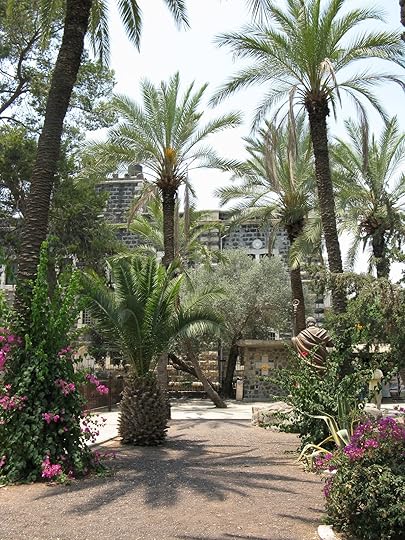 Gardens of the Heptagon at TagbaAs evening fell the disciples came to their teacher and suggested he allow the multitude to go find food for supper. Jesus knew they must be hungry and asked his disciples to find them food so they would not overwhelm the villages in the area. The disciples looked at the crowd and said this would be quite expensive and was not affordable. But Jesus insisted, “They do not need to go away. You give them something to eat.”
Gardens of the Heptagon at TagbaAs evening fell the disciples came to their teacher and suggested he allow the multitude to go find food for supper. Jesus knew they must be hungry and asked his disciples to find them food so they would not overwhelm the villages in the area. The disciples looked at the crowd and said this would be quite expensive and was not affordable. But Jesus insisted, “They do not need to go away. You give them something to eat.”
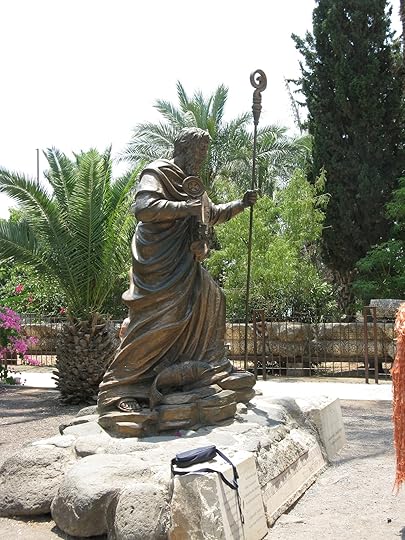 A statue of a disciple at the Heptagon at TagbaWhile most of the disciples were wondering how to do this, Andrew went out into the crowd. He found a boy who brought a lunch with two fish and five pieces of bread. The boy had listened to Jesus so intently that he had not eaten his lunch. Andrew asked if the boy would offer his lunch to Jesus and the boy immediately said yes.
A statue of a disciple at the Heptagon at TagbaWhile most of the disciples were wondering how to do this, Andrew went out into the crowd. He found a boy who brought a lunch with two fish and five pieces of bread. The boy had listened to Jesus so intently that he had not eaten his lunch. Andrew asked if the boy would offer his lunch to Jesus and the boy immediately said yes.
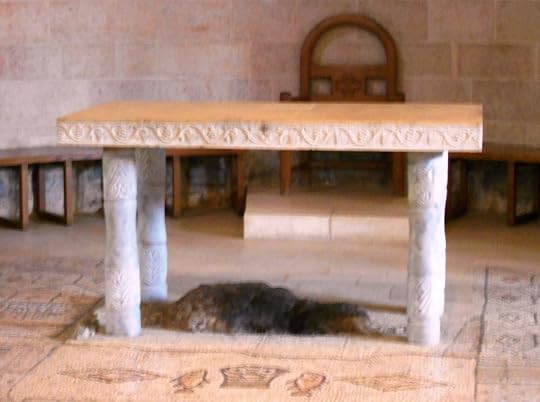 The altar where Jesus blessed the fish and the loavesJesus received the two fish from the boy, which had been caught in the waters of Tagba, blessed them along with the bread, and distributed the boy’s lunch to the disciples in order to be shared among the multitude of people. As the disciples broke tiny pieces off the loaves of bread and filet of fish, so they would not run out, both the minuscule serving and the source of the serving grew and replenished itself so the small meal brought by a young boy was enough to feed everyone. A miracle occurred which reminded the disciples of Elijah’s multiplication of flour and oil in 1 Kings 17. Jesus compared it to the provision of manna and quail during Israel’s forty years of living in the desert. [Mt 14:13-21; Mark 6:32-44; Luke 9:12-17; John 6]
The altar where Jesus blessed the fish and the loavesJesus received the two fish from the boy, which had been caught in the waters of Tagba, blessed them along with the bread, and distributed the boy’s lunch to the disciples in order to be shared among the multitude of people. As the disciples broke tiny pieces off the loaves of bread and filet of fish, so they would not run out, both the minuscule serving and the source of the serving grew and replenished itself so the small meal brought by a young boy was enough to feed everyone. A miracle occurred which reminded the disciples of Elijah’s multiplication of flour and oil in 1 Kings 17. Jesus compared it to the provision of manna and quail during Israel’s forty years of living in the desert. [Mt 14:13-21; Mark 6:32-44; Luke 9:12-17; John 6]
 Guidebook for Visitors to IsraelYou can learn more about the place where the miracle took place in the book Israel: Stories for Your Journey, available on Kindle Reader for $2. Over 250 stories are contained in this new travel guide which covers most Christian tourist sites in Israel. This easy read will be of benefit to every person who plans on traveling to israel.
Guidebook for Visitors to IsraelYou can learn more about the place where the miracle took place in the book Israel: Stories for Your Journey, available on Kindle Reader for $2. Over 250 stories are contained in this new travel guide which covers most Christian tourist sites in Israel. This easy read will be of benefit to every person who plans on traveling to israel.
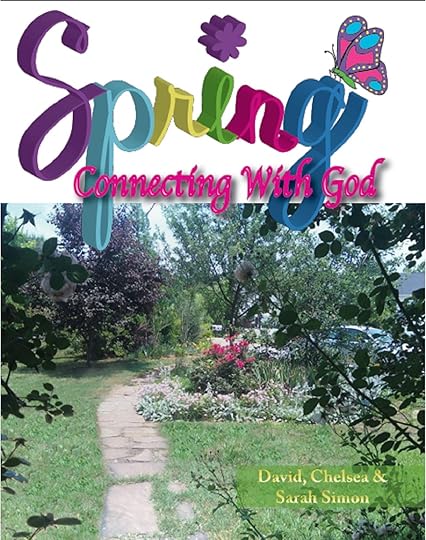 This book relates how the feeding of the 5,000 relates to PassoverThe book
Spring; Connecting with God
contains many more details about the feeding of the 5,000, including how this seaside meal connects to the Passover of the Jews and Jesus’ Last Supper.
This book relates how the feeding of the 5,000 relates to PassoverThe book
Spring; Connecting with God
contains many more details about the feeding of the 5,000, including how this seaside meal connects to the Passover of the Jews and Jesus’ Last Supper.
 View of the Sea of Galilee from CapernaumThe second year of Jesus’ ministry is called “the year of popularity.” People were responding to His miracles and desired to hear His teachings. During Passover, people received word that Jesus was in the area and gathered to hear him near Tagba, on the shore of the Sea of Galilee. Tagba is a very fertile area where the fish are especially thick in the sea because seven warm springs release mineral rich water the area. (Read more about the area in Israel: Stories for Your Journey)
View of the Sea of Galilee from CapernaumThe second year of Jesus’ ministry is called “the year of popularity.” People were responding to His miracles and desired to hear His teachings. During Passover, people received word that Jesus was in the area and gathered to hear him near Tagba, on the shore of the Sea of Galilee. Tagba is a very fertile area where the fish are especially thick in the sea because seven warm springs release mineral rich water the area. (Read more about the area in Israel: Stories for Your Journey) View of the north shore of the Sea of Galilee near TagbaPeople gathered into a natural amphitheater near the warm springs in especially large numbers in order to listen to Jesus. The conservative count of the people who attended this teaching session was 5000 men, plus women and children. The crowd came from Capernaum, Bethsaida, Magdala, and other villages along the northern shore of the Sea of Galilee. There were also people from Gadara, Hippos and the eastern side of the sea.
View of the north shore of the Sea of Galilee near TagbaPeople gathered into a natural amphitheater near the warm springs in especially large numbers in order to listen to Jesus. The conservative count of the people who attended this teaching session was 5000 men, plus women and children. The crowd came from Capernaum, Bethsaida, Magdala, and other villages along the northern shore of the Sea of Galilee. There were also people from Gadara, Hippos and the eastern side of the sea. A pond in the chapel at TaagbaThe multitude of people listened attentively as Jesus taught. He taught with richness of content, clarity of words, and great authority. He shared beatitudes to be followed in life along with teachings on prayer, humility and charity. The people listened to every word. Jesus spoke for many hours, and the attentiveness of the people never wavered.
A pond in the chapel at TaagbaThe multitude of people listened attentively as Jesus taught. He taught with richness of content, clarity of words, and great authority. He shared beatitudes to be followed in life along with teachings on prayer, humility and charity. The people listened to every word. Jesus spoke for many hours, and the attentiveness of the people never wavered. Gardens of the Heptagon at TagbaAs evening fell the disciples came to their teacher and suggested he allow the multitude to go find food for supper. Jesus knew they must be hungry and asked his disciples to find them food so they would not overwhelm the villages in the area. The disciples looked at the crowd and said this would be quite expensive and was not affordable. But Jesus insisted, “They do not need to go away. You give them something to eat.”
Gardens of the Heptagon at TagbaAs evening fell the disciples came to their teacher and suggested he allow the multitude to go find food for supper. Jesus knew they must be hungry and asked his disciples to find them food so they would not overwhelm the villages in the area. The disciples looked at the crowd and said this would be quite expensive and was not affordable. But Jesus insisted, “They do not need to go away. You give them something to eat.” A statue of a disciple at the Heptagon at TagbaWhile most of the disciples were wondering how to do this, Andrew went out into the crowd. He found a boy who brought a lunch with two fish and five pieces of bread. The boy had listened to Jesus so intently that he had not eaten his lunch. Andrew asked if the boy would offer his lunch to Jesus and the boy immediately said yes.
A statue of a disciple at the Heptagon at TagbaWhile most of the disciples were wondering how to do this, Andrew went out into the crowd. He found a boy who brought a lunch with two fish and five pieces of bread. The boy had listened to Jesus so intently that he had not eaten his lunch. Andrew asked if the boy would offer his lunch to Jesus and the boy immediately said yes. The altar where Jesus blessed the fish and the loavesJesus received the two fish from the boy, which had been caught in the waters of Tagba, blessed them along with the bread, and distributed the boy’s lunch to the disciples in order to be shared among the multitude of people. As the disciples broke tiny pieces off the loaves of bread and filet of fish, so they would not run out, both the minuscule serving and the source of the serving grew and replenished itself so the small meal brought by a young boy was enough to feed everyone. A miracle occurred which reminded the disciples of Elijah’s multiplication of flour and oil in 1 Kings 17. Jesus compared it to the provision of manna and quail during Israel’s forty years of living in the desert. [Mt 14:13-21; Mark 6:32-44; Luke 9:12-17; John 6]
The altar where Jesus blessed the fish and the loavesJesus received the two fish from the boy, which had been caught in the waters of Tagba, blessed them along with the bread, and distributed the boy’s lunch to the disciples in order to be shared among the multitude of people. As the disciples broke tiny pieces off the loaves of bread and filet of fish, so they would not run out, both the minuscule serving and the source of the serving grew and replenished itself so the small meal brought by a young boy was enough to feed everyone. A miracle occurred which reminded the disciples of Elijah’s multiplication of flour and oil in 1 Kings 17. Jesus compared it to the provision of manna and quail during Israel’s forty years of living in the desert. [Mt 14:13-21; Mark 6:32-44; Luke 9:12-17; John 6] Guidebook for Visitors to IsraelYou can learn more about the place where the miracle took place in the book Israel: Stories for Your Journey, available on Kindle Reader for $2. Over 250 stories are contained in this new travel guide which covers most Christian tourist sites in Israel. This easy read will be of benefit to every person who plans on traveling to israel.
Guidebook for Visitors to IsraelYou can learn more about the place where the miracle took place in the book Israel: Stories for Your Journey, available on Kindle Reader for $2. Over 250 stories are contained in this new travel guide which covers most Christian tourist sites in Israel. This easy read will be of benefit to every person who plans on traveling to israel. This book relates how the feeding of the 5,000 relates to PassoverThe book
Spring; Connecting with God
contains many more details about the feeding of the 5,000, including how this seaside meal connects to the Passover of the Jews and Jesus’ Last Supper.
This book relates how the feeding of the 5,000 relates to PassoverThe book
Spring; Connecting with God
contains many more details about the feeding of the 5,000, including how this seaside meal connects to the Passover of the Jews and Jesus’ Last Supper.
Published on March 05, 2018 03:30
March 2, 2018
Life along the Sea of Galilee
I have often wondered what life was like along the shore of the Sea of Galilee during the first century. As I read the Bible I see hand picked events which were written to make a point for readers. On guided tours I travel along the shore in a large passenger bus, flying by the places of the Bible far too rapidly to absorb the scene. When I sail on a boat, I get the feel of the water, but realize the shoreline has changed. The Sea of Tiberias contains far more windsurfers than fishing boats.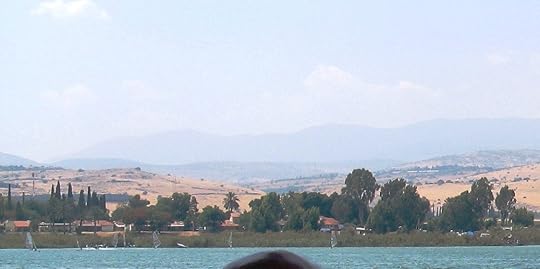 Windsurfers along the north shore of the Sea of GalileeIn the first century a major industry on the Sea of Galilee was fishing. Today it is tourism. In various places motels nestle against the shoreline in order to give tourists the opportunity to experience the Lake of Gennesaret as it was in the days of Jesus. The places the Savior was known to frequent in the region have been altered from their original setting to a church site. Lake Kinneret is there, the mountains which have always surrounded the water are there, but the landscape of the first century has totally changed.
Windsurfers along the north shore of the Sea of GalileeIn the first century a major industry on the Sea of Galilee was fishing. Today it is tourism. In various places motels nestle against the shoreline in order to give tourists the opportunity to experience the Lake of Gennesaret as it was in the days of Jesus. The places the Savior was known to frequent in the region have been altered from their original setting to a church site. Lake Kinneret is there, the mountains which have always surrounded the water are there, but the landscape of the first century has totally changed.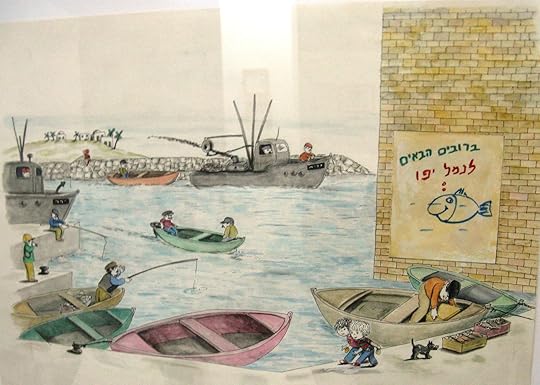 Painting from the Sea of GalileeTwo thousand years have passed since the man named Jesus walked along the shore of the Sea of Galilee with his twelve disciples. Across the years so much has changed that archaeologists at times are not sure if the remains they find belong to a village listed in the Bible, or if it is some other place.
Painting from the Sea of GalileeTwo thousand years have passed since the man named Jesus walked along the shore of the Sea of Galilee with his twelve disciples. Across the years so much has changed that archaeologists at times are not sure if the remains they find belong to a village listed in the Bible, or if it is some other place.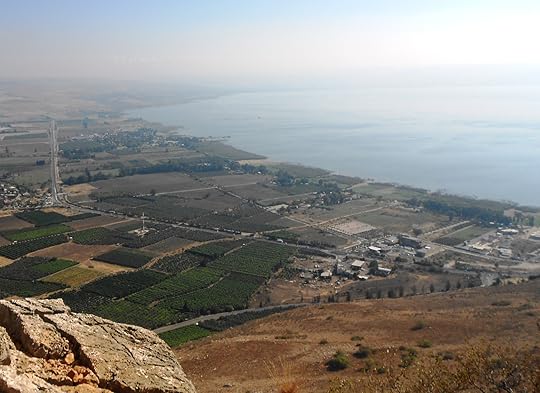 The northern quadrant of the Sea of Galilee from Mount ArbelRecently, the Sea of Galilee experienced a drought. Because of water usage and limited rainfall the level of the water dropped to a “new” low which has not been seen in years. Although the lack of water is not a good thing, there was one benefit that came from the drought. Old portages, long since forgotten about, came to be seen. The stone foundations of fishing piers appeared to be researched and photographed.
The northern quadrant of the Sea of Galilee from Mount ArbelRecently, the Sea of Galilee experienced a drought. Because of water usage and limited rainfall the level of the water dropped to a “new” low which has not been seen in years. Although the lack of water is not a good thing, there was one benefit that came from the drought. Old portages, long since forgotten about, came to be seen. The stone foundations of fishing piers appeared to be researched and photographed.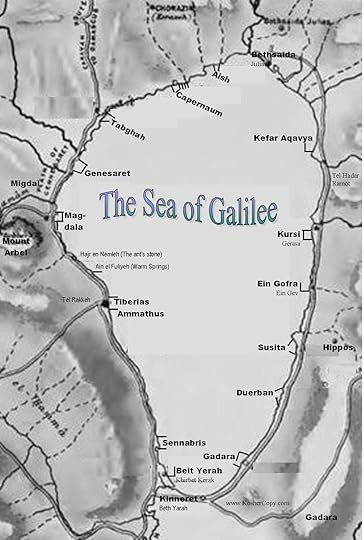 Harbors along the Sea of GalileeBecause of this, there is an idea of where fishing villages existed and where the men of Jesus’ day docked their boats. In 1986, during a previous drought, a boat was found that had been preserved in the mud since the first century. Today it is on display at the Kibbutz where it was found, and also a copy can be found in a museum at Haifa. This year it is believed the city of Bethsaida has been unearthed in a place which was formerly submerged.
Harbors along the Sea of GalileeBecause of this, there is an idea of where fishing villages existed and where the men of Jesus’ day docked their boats. In 1986, during a previous drought, a boat was found that had been preserved in the mud since the first century. Today it is on display at the Kibbutz where it was found, and also a copy can be found in a museum at Haifa. This year it is believed the city of Bethsaida has been unearthed in a place which was formerly submerged. 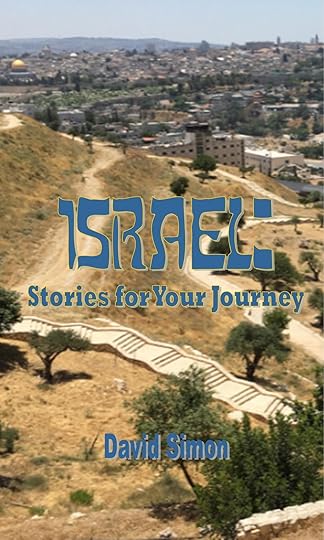 The perfect companion for visitors to IsraelIn my visits to Israel, in my Bible Study, and when I teach, I try to imagine what life was like along the shore of the Sea of Galilee during the time Jesus walked along its shore. I have collected some stories of my research in a new book Israel: Stories for Your Journey. This $2 Kindle book shares how Capernaum and Tiberias were started alongside other stories from the past in order to give an idea of what it was like to live and work in the first century. This book should be read by anyone going on a trip to the Holy Land.
The perfect companion for visitors to IsraelIn my visits to Israel, in my Bible Study, and when I teach, I try to imagine what life was like along the shore of the Sea of Galilee during the time Jesus walked along its shore. I have collected some stories of my research in a new book Israel: Stories for Your Journey. This $2 Kindle book shares how Capernaum and Tiberias were started alongside other stories from the past in order to give an idea of what it was like to live and work in the first century. This book should be read by anyone going on a trip to the Holy Land. 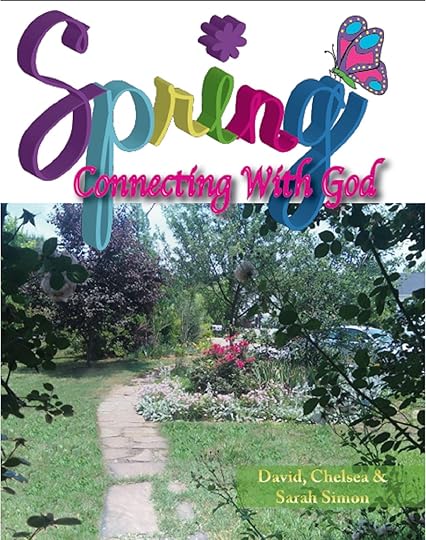 Passover in the lives of People during Bible times and after.I have also written about life along the Sea of Galilee in my book Spring: Connecting with God. This book looks at how Passover was celebrated in the time of Jesus. The section on the feeding of the 5,000 relates details of Jewish tradition that bring John’s story of the event to life. One of my passions is to help the Bible come to life so people will understand the stories of this book really happened to real people.
Passover in the lives of People during Bible times and after.I have also written about life along the Sea of Galilee in my book Spring: Connecting with God. This book looks at how Passover was celebrated in the time of Jesus. The section on the feeding of the 5,000 relates details of Jewish tradition that bring John’s story of the event to life. One of my passions is to help the Bible come to life so people will understand the stories of this book really happened to real people.
 Windsurfers along the north shore of the Sea of GalileeIn the first century a major industry on the Sea of Galilee was fishing. Today it is tourism. In various places motels nestle against the shoreline in order to give tourists the opportunity to experience the Lake of Gennesaret as it was in the days of Jesus. The places the Savior was known to frequent in the region have been altered from their original setting to a church site. Lake Kinneret is there, the mountains which have always surrounded the water are there, but the landscape of the first century has totally changed.
Windsurfers along the north shore of the Sea of GalileeIn the first century a major industry on the Sea of Galilee was fishing. Today it is tourism. In various places motels nestle against the shoreline in order to give tourists the opportunity to experience the Lake of Gennesaret as it was in the days of Jesus. The places the Savior was known to frequent in the region have been altered from their original setting to a church site. Lake Kinneret is there, the mountains which have always surrounded the water are there, but the landscape of the first century has totally changed. Painting from the Sea of GalileeTwo thousand years have passed since the man named Jesus walked along the shore of the Sea of Galilee with his twelve disciples. Across the years so much has changed that archaeologists at times are not sure if the remains they find belong to a village listed in the Bible, or if it is some other place.
Painting from the Sea of GalileeTwo thousand years have passed since the man named Jesus walked along the shore of the Sea of Galilee with his twelve disciples. Across the years so much has changed that archaeologists at times are not sure if the remains they find belong to a village listed in the Bible, or if it is some other place. The northern quadrant of the Sea of Galilee from Mount ArbelRecently, the Sea of Galilee experienced a drought. Because of water usage and limited rainfall the level of the water dropped to a “new” low which has not been seen in years. Although the lack of water is not a good thing, there was one benefit that came from the drought. Old portages, long since forgotten about, came to be seen. The stone foundations of fishing piers appeared to be researched and photographed.
The northern quadrant of the Sea of Galilee from Mount ArbelRecently, the Sea of Galilee experienced a drought. Because of water usage and limited rainfall the level of the water dropped to a “new” low which has not been seen in years. Although the lack of water is not a good thing, there was one benefit that came from the drought. Old portages, long since forgotten about, came to be seen. The stone foundations of fishing piers appeared to be researched and photographed. Harbors along the Sea of GalileeBecause of this, there is an idea of where fishing villages existed and where the men of Jesus’ day docked their boats. In 1986, during a previous drought, a boat was found that had been preserved in the mud since the first century. Today it is on display at the Kibbutz where it was found, and also a copy can be found in a museum at Haifa. This year it is believed the city of Bethsaida has been unearthed in a place which was formerly submerged.
Harbors along the Sea of GalileeBecause of this, there is an idea of where fishing villages existed and where the men of Jesus’ day docked their boats. In 1986, during a previous drought, a boat was found that had been preserved in the mud since the first century. Today it is on display at the Kibbutz where it was found, and also a copy can be found in a museum at Haifa. This year it is believed the city of Bethsaida has been unearthed in a place which was formerly submerged.  The perfect companion for visitors to IsraelIn my visits to Israel, in my Bible Study, and when I teach, I try to imagine what life was like along the shore of the Sea of Galilee during the time Jesus walked along its shore. I have collected some stories of my research in a new book Israel: Stories for Your Journey. This $2 Kindle book shares how Capernaum and Tiberias were started alongside other stories from the past in order to give an idea of what it was like to live and work in the first century. This book should be read by anyone going on a trip to the Holy Land.
The perfect companion for visitors to IsraelIn my visits to Israel, in my Bible Study, and when I teach, I try to imagine what life was like along the shore of the Sea of Galilee during the time Jesus walked along its shore. I have collected some stories of my research in a new book Israel: Stories for Your Journey. This $2 Kindle book shares how Capernaum and Tiberias were started alongside other stories from the past in order to give an idea of what it was like to live and work in the first century. This book should be read by anyone going on a trip to the Holy Land.  Passover in the lives of People during Bible times and after.I have also written about life along the Sea of Galilee in my book Spring: Connecting with God. This book looks at how Passover was celebrated in the time of Jesus. The section on the feeding of the 5,000 relates details of Jewish tradition that bring John’s story of the event to life. One of my passions is to help the Bible come to life so people will understand the stories of this book really happened to real people.
Passover in the lives of People during Bible times and after.I have also written about life along the Sea of Galilee in my book Spring: Connecting with God. This book looks at how Passover was celebrated in the time of Jesus. The section on the feeding of the 5,000 relates details of Jewish tradition that bring John’s story of the event to life. One of my passions is to help the Bible come to life so people will understand the stories of this book really happened to real people.
Published on March 02, 2018 03:30
February 28, 2018
The Damascus Gate
It is amazing what sights escape us when we don’t know what is right in front of our eyes. At the Damascus Gate there is a gate below the gate. I have walked through his gate many times when visiting Jerusalem, but until i studied for new book
Israel: Stories for Your Journey
, I totally missed the interesting Roman period entry which was literally right in front of me as I entered Jerusalem through this northernmost portal.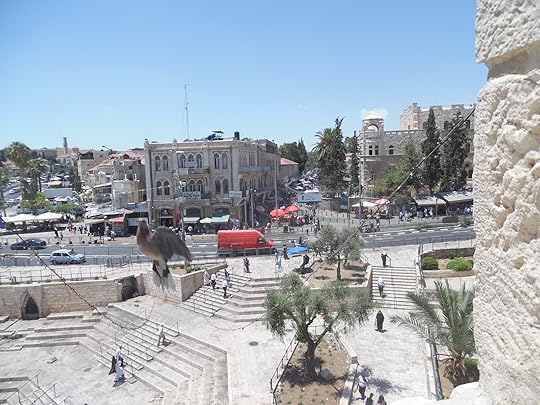 A look north from the Ramparts Walk above the Damascus Gate.
A look north from the Ramparts Walk above the Damascus Gate.
Do you see what is right in front of your eyes?The Damascus gate is the grand northern entrance to the Old City of Jerusalem. It is on the main road leading out of Jerusalem northward, in the direction of Nablus (Shechem), Galilee and Damascus. It is the main entry into the Muslim Quarter, with its markets both inside the gate and a bazaar on the entry plaza on Thursday night. This major gate was the northern entry to the cardo, the main street of Jerusalem from the Roman period to our present time, which is the starting point of telling about the gate below the gate.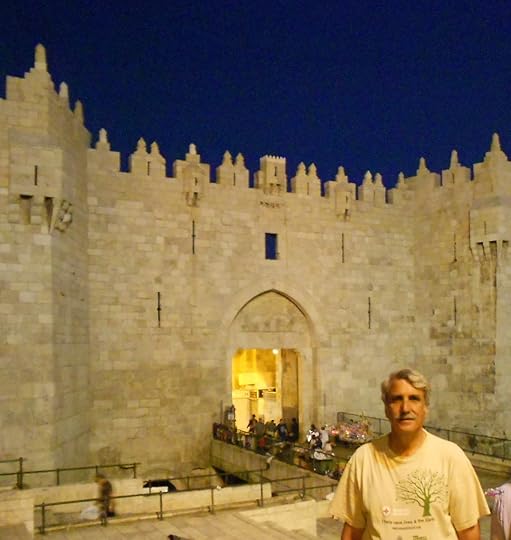 A look at the Damascus Gate, The Roman entry
A look at the Damascus Gate, The Roman entry
can be seen below the walkway to the left.After Jerusalem was subdued by both general Titus and by Hadrian, the emperor decided to rebuild and rename the city in order to demean the Jewish population. The new city was called Aelia Capitolina. Aelia was the emperor’s family name and celebrates the greatness of Hadrian. Capitolina praises a triad of Roman gods: Jupiter, Juno and Minerva. The city was built in the shape of a square with the main roads entering near today's Damascus Gate, Jaffa Gate, Zion Gate and the Stephen Gates. The second century Roman style entry consisted of a grand victory arch set between two smaller arches, a victory symbol which sometimes stood in an area which was in front of the city gates. Beyond the entrance stood a pillar with the bust of the Roman Emperor.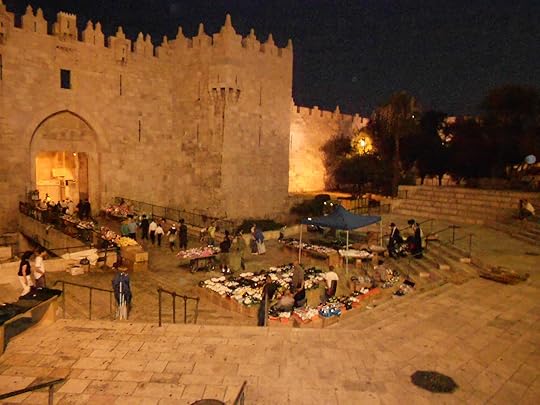 The Thursday Night Bazaar at the Damascus GateAs a person enters the Damascus gate today, the small Roman arches can be seen to the south and below the current gate reconstructed by Suleiman the Magnificent in the sixteenth century. The name Aelia Capitolina is emblazoned in Latin above the entrance and the original Roman pavers lead to a plaza with the remains of Hadrian’s pillar. From there a twenty-six foot wide cardo flanked by rows of columns and five foot wide raised sidewalks used to lead into the city.
The Thursday Night Bazaar at the Damascus GateAs a person enters the Damascus gate today, the small Roman arches can be seen to the south and below the current gate reconstructed by Suleiman the Magnificent in the sixteenth century. The name Aelia Capitolina is emblazoned in Latin above the entrance and the original Roman pavers lead to a plaza with the remains of Hadrian’s pillar. From there a twenty-six foot wide cardo flanked by rows of columns and five foot wide raised sidewalks used to lead into the city. Our travel brochure available at www.KosherCopy.com
Our travel brochure available at www.KosherCopy.com
If you would like to see the Damascus Gate, and many other sights in Jerusalem and Israel, take a look at my May adventure in the Holy Land (link). If you can’t make it on the trip, please order my book, Israel: Stories for Your Journey and take a look at my blog during the month of May.
 A look north from the Ramparts Walk above the Damascus Gate.
A look north from the Ramparts Walk above the Damascus Gate. Do you see what is right in front of your eyes?The Damascus gate is the grand northern entrance to the Old City of Jerusalem. It is on the main road leading out of Jerusalem northward, in the direction of Nablus (Shechem), Galilee and Damascus. It is the main entry into the Muslim Quarter, with its markets both inside the gate and a bazaar on the entry plaza on Thursday night. This major gate was the northern entry to the cardo, the main street of Jerusalem from the Roman period to our present time, which is the starting point of telling about the gate below the gate.
 A look at the Damascus Gate, The Roman entry
A look at the Damascus Gate, The Roman entry can be seen below the walkway to the left.After Jerusalem was subdued by both general Titus and by Hadrian, the emperor decided to rebuild and rename the city in order to demean the Jewish population. The new city was called Aelia Capitolina. Aelia was the emperor’s family name and celebrates the greatness of Hadrian. Capitolina praises a triad of Roman gods: Jupiter, Juno and Minerva. The city was built in the shape of a square with the main roads entering near today's Damascus Gate, Jaffa Gate, Zion Gate and the Stephen Gates. The second century Roman style entry consisted of a grand victory arch set between two smaller arches, a victory symbol which sometimes stood in an area which was in front of the city gates. Beyond the entrance stood a pillar with the bust of the Roman Emperor.
 The Thursday Night Bazaar at the Damascus GateAs a person enters the Damascus gate today, the small Roman arches can be seen to the south and below the current gate reconstructed by Suleiman the Magnificent in the sixteenth century. The name Aelia Capitolina is emblazoned in Latin above the entrance and the original Roman pavers lead to a plaza with the remains of Hadrian’s pillar. From there a twenty-six foot wide cardo flanked by rows of columns and five foot wide raised sidewalks used to lead into the city.
The Thursday Night Bazaar at the Damascus GateAs a person enters the Damascus gate today, the small Roman arches can be seen to the south and below the current gate reconstructed by Suleiman the Magnificent in the sixteenth century. The name Aelia Capitolina is emblazoned in Latin above the entrance and the original Roman pavers lead to a plaza with the remains of Hadrian’s pillar. From there a twenty-six foot wide cardo flanked by rows of columns and five foot wide raised sidewalks used to lead into the city. Our travel brochure available at www.KosherCopy.com
Our travel brochure available at www.KosherCopy.comIf you would like to see the Damascus Gate, and many other sights in Jerusalem and Israel, take a look at my May adventure in the Holy Land (link). If you can’t make it on the trip, please order my book, Israel: Stories for Your Journey and take a look at my blog during the month of May.
Published on February 28, 2018 00:00
February 23, 2018
The Four Sons for Daughters
February is a month of birthdays for our family, both of my daughters were born in the month of February. We celebrate their birthdays no matter where they are in the world. Families are support systems and birthdays are supposed to be fun. Because Purim is next week, I must add that I am sure Mordecai would never forget Esther’s birthday, and probably made sure she had fun.
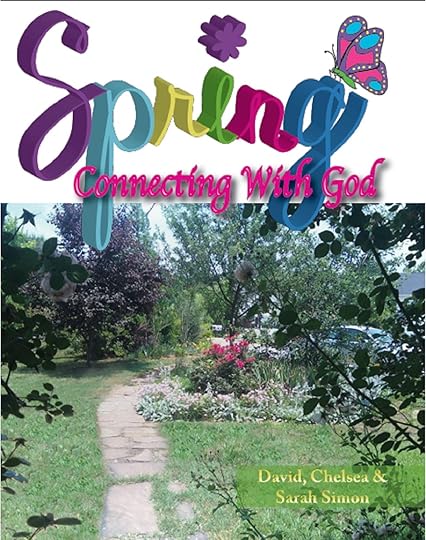 Spiritual Life and a Relationship with GodIn my blog I often write about Passover during this time of year. That is partially to promote the fact that I lead Passover Seders, and partly to promote two books I have written with my daughters. (They are available in print and on kindle). The Passover was instituted in order to help our children learn about God’s care for His people. Various instruments are used during the Pesach celebration to share God’s desires.
Spiritual Life and a Relationship with GodIn my blog I often write about Passover during this time of year. That is partially to promote the fact that I lead Passover Seders, and partly to promote two books I have written with my daughters. (They are available in print and on kindle). The Passover was instituted in order to help our children learn about God’s care for His people. Various instruments are used during the Pesach celebration to share God’s desires.
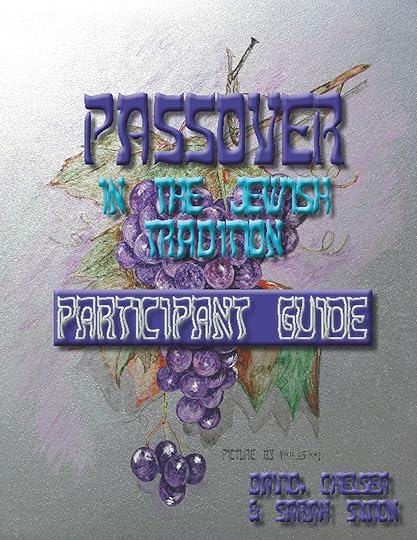 Passover Seder participant HaggadahThe Passover Haggadah tells about four sons through four questions and answers given to children in the Torah. The Rabbis use the questions to teach about four types of people in the world: The wise, the wicked, the simple and the young.
Passover Seder participant HaggadahThe Passover Haggadah tells about four sons through four questions and answers given to children in the Torah. The Rabbis use the questions to teach about four types of people in the world: The wise, the wicked, the simple and the young.
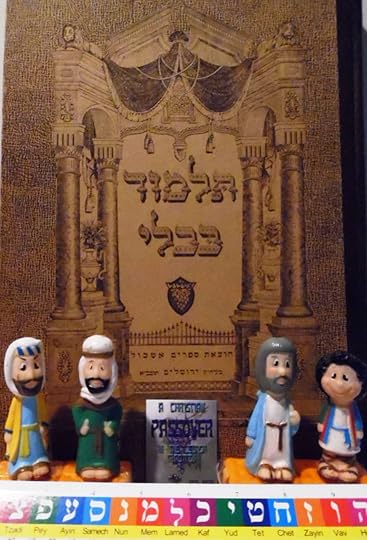 Four Sons and Four types of people
Four Sons and Four types of people
The fourth son of the Seder is the young child. From Exodus 13:8, we discern that this son is very young, too young to ask a question, because. Moses instructed the fathers to answer their child without a question ever being asked. The Bible tells us, “You shall tell your son on that day, ‘It is because of what the Lord did for me when I came out of Egypt.’”
The message of Exodus 13:8 is very important for parents of today. Our children are always learning, and we should always be teaching. When my children were very young, even a few days old, I enjoyed holding them and teaching them. My teaching at that age was mostly in songs I sang to my daughters. They did not ask questions, they did not speak back. They only girlgled, smiled or, sometimes, cried.
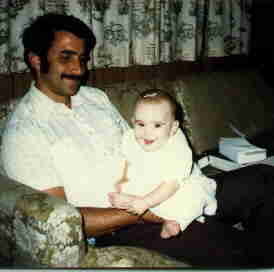 Dad and DaughterBut as I sang and as I spoke, my children learned. Their minds were opened, and they understood the language of love, and they were learning the words I shared with them. On the day of a child’s birth we begin to teach them about life, and hopefully about God. I shared with my daughters “because of what the Lord did for me when I came out of Egypt.”
Dad and DaughterBut as I sang and as I spoke, my children learned. Their minds were opened, and they understood the language of love, and they were learning the words I shared with them. On the day of a child’s birth we begin to teach them about life, and hopefully about God. I shared with my daughters “because of what the Lord did for me when I came out of Egypt.”
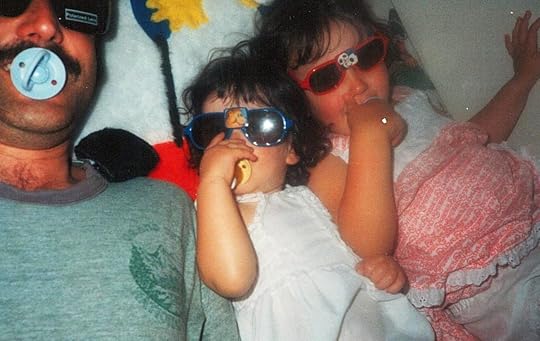 Story time and then nap time
Story time and then nap time
As my children grew older, they learned to ask simple questions. About two or three years old they constantly asked, “Why?” THe question is only one word long, but it can be applied in so many ways. The natural inclination is to push a child aside, because, as a parent, you get tired of hearing the constant, “Why?” and then when you answer the question, another “Why?” And another and another.
For the child who asks lots of “Why?” or other simple questions, Moses wrote, “when in time to come your son asks you, ‘What does this mean?’ (or ‘Why?’) you shall say to him, ‘By a strong hand the Lord brought us out of Egypt, from the house of slavery.” (Exodus 13:14)
 Chelsea and her GrandmotherThe Bible tells me never to tire of my children’s questions, for they are a source of learning. In my educational courses, I learned to use teachable moments with my classes. Whenever a child asks a question, they are sharing a teachable moment. The child’s intention is to be discerned so their question can be answered. (Sometimes the question is so simple it is ambiguous. It is up to the parent to know their child and the situation well enough to give an applicable answer). As questions are appropriately answered and as teachable moments are used to instruct children, they learn and grow, and come to know God’s love more clearly.
Chelsea and her GrandmotherThe Bible tells me never to tire of my children’s questions, for they are a source of learning. In my educational courses, I learned to use teachable moments with my classes. Whenever a child asks a question, they are sharing a teachable moment. The child’s intention is to be discerned so their question can be answered. (Sometimes the question is so simple it is ambiguous. It is up to the parent to know their child and the situation well enough to give an applicable answer). As questions are appropriately answered and as teachable moments are used to instruct children, they learn and grow, and come to know God’s love more clearly.
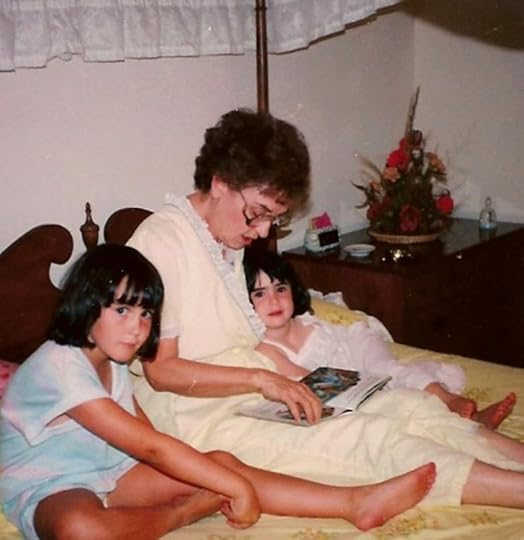 A Grandmother's Bedtime Routine
A Grandmother's Bedtime Routine
The second son in the Passover Seder asks the question, “What do YOU mean by this service?” (Exodus 12:26) The child who asks this question is called ‘the wicked son,’ because he wishes he could be excluded from the Passover and from his family's teachings. This indeed is a sad situation, for it means the teachings did not take. Fortunately, I did not have to deal with this type of child. Because I started to teach my children when they were young, and because I was patent when they got older, and because I sought to bring ‘the joy of the Lord’ into our faith, my children grew up to adopt our religion, rather than to reject it.
If I were asked, “Do your children believe and practice exactly as you do?” I would have to answer no, because each person’s faith walk will be a bit different. But certainly we worship the same God, and hold to the same faith, and there is a bond. My daughters have now passed the three decade mark, and therefore we can have discussions about religion. I can learn from them, as they have learned from me.
My daughters are now like the wise son, who asks, “What is the meaning of the testimonies and the statutes and the rules that the Lord our God has commanded you?” (Deut 6:20) They have gone to school, become learned, and now they teach others, and sometimes they teach me.
I recently read on a Chabad website: “Since all of Torah addresses all of Israel, we must say that all four messages of the Torah are applicable to all of us, since we all possess the “four children” within ourselves. We are therefore all required—even one who does not have children—to recite all four answers, since we are in essence speaking to the wise, wicked, simple, and “unable to ask” elements that exist within every one of us.”
 Spiritual Life and a Relationship with GodIn my blog I often write about Passover during this time of year. That is partially to promote the fact that I lead Passover Seders, and partly to promote two books I have written with my daughters. (They are available in print and on kindle). The Passover was instituted in order to help our children learn about God’s care for His people. Various instruments are used during the Pesach celebration to share God’s desires.
Spiritual Life and a Relationship with GodIn my blog I often write about Passover during this time of year. That is partially to promote the fact that I lead Passover Seders, and partly to promote two books I have written with my daughters. (They are available in print and on kindle). The Passover was instituted in order to help our children learn about God’s care for His people. Various instruments are used during the Pesach celebration to share God’s desires. Passover Seder participant HaggadahThe Passover Haggadah tells about four sons through four questions and answers given to children in the Torah. The Rabbis use the questions to teach about four types of people in the world: The wise, the wicked, the simple and the young.
Passover Seder participant HaggadahThe Passover Haggadah tells about four sons through four questions and answers given to children in the Torah. The Rabbis use the questions to teach about four types of people in the world: The wise, the wicked, the simple and the young. Four Sons and Four types of people
Four Sons and Four types of peopleThe fourth son of the Seder is the young child. From Exodus 13:8, we discern that this son is very young, too young to ask a question, because. Moses instructed the fathers to answer their child without a question ever being asked. The Bible tells us, “You shall tell your son on that day, ‘It is because of what the Lord did for me when I came out of Egypt.’”
The message of Exodus 13:8 is very important for parents of today. Our children are always learning, and we should always be teaching. When my children were very young, even a few days old, I enjoyed holding them and teaching them. My teaching at that age was mostly in songs I sang to my daughters. They did not ask questions, they did not speak back. They only girlgled, smiled or, sometimes, cried.
 Dad and DaughterBut as I sang and as I spoke, my children learned. Their minds were opened, and they understood the language of love, and they were learning the words I shared with them. On the day of a child’s birth we begin to teach them about life, and hopefully about God. I shared with my daughters “because of what the Lord did for me when I came out of Egypt.”
Dad and DaughterBut as I sang and as I spoke, my children learned. Their minds were opened, and they understood the language of love, and they were learning the words I shared with them. On the day of a child’s birth we begin to teach them about life, and hopefully about God. I shared with my daughters “because of what the Lord did for me when I came out of Egypt.” Story time and then nap time
Story time and then nap timeAs my children grew older, they learned to ask simple questions. About two or three years old they constantly asked, “Why?” THe question is only one word long, but it can be applied in so many ways. The natural inclination is to push a child aside, because, as a parent, you get tired of hearing the constant, “Why?” and then when you answer the question, another “Why?” And another and another.
For the child who asks lots of “Why?” or other simple questions, Moses wrote, “when in time to come your son asks you, ‘What does this mean?’ (or ‘Why?’) you shall say to him, ‘By a strong hand the Lord brought us out of Egypt, from the house of slavery.” (Exodus 13:14)
 Chelsea and her GrandmotherThe Bible tells me never to tire of my children’s questions, for they are a source of learning. In my educational courses, I learned to use teachable moments with my classes. Whenever a child asks a question, they are sharing a teachable moment. The child’s intention is to be discerned so their question can be answered. (Sometimes the question is so simple it is ambiguous. It is up to the parent to know their child and the situation well enough to give an applicable answer). As questions are appropriately answered and as teachable moments are used to instruct children, they learn and grow, and come to know God’s love more clearly.
Chelsea and her GrandmotherThe Bible tells me never to tire of my children’s questions, for they are a source of learning. In my educational courses, I learned to use teachable moments with my classes. Whenever a child asks a question, they are sharing a teachable moment. The child’s intention is to be discerned so their question can be answered. (Sometimes the question is so simple it is ambiguous. It is up to the parent to know their child and the situation well enough to give an applicable answer). As questions are appropriately answered and as teachable moments are used to instruct children, they learn and grow, and come to know God’s love more clearly. A Grandmother's Bedtime Routine
A Grandmother's Bedtime RoutineThe second son in the Passover Seder asks the question, “What do YOU mean by this service?” (Exodus 12:26) The child who asks this question is called ‘the wicked son,’ because he wishes he could be excluded from the Passover and from his family's teachings. This indeed is a sad situation, for it means the teachings did not take. Fortunately, I did not have to deal with this type of child. Because I started to teach my children when they were young, and because I was patent when they got older, and because I sought to bring ‘the joy of the Lord’ into our faith, my children grew up to adopt our religion, rather than to reject it.
If I were asked, “Do your children believe and practice exactly as you do?” I would have to answer no, because each person’s faith walk will be a bit different. But certainly we worship the same God, and hold to the same faith, and there is a bond. My daughters have now passed the three decade mark, and therefore we can have discussions about religion. I can learn from them, as they have learned from me.
My daughters are now like the wise son, who asks, “What is the meaning of the testimonies and the statutes and the rules that the Lord our God has commanded you?” (Deut 6:20) They have gone to school, become learned, and now they teach others, and sometimes they teach me.
I recently read on a Chabad website: “Since all of Torah addresses all of Israel, we must say that all four messages of the Torah are applicable to all of us, since we all possess the “four children” within ourselves. We are therefore all required—even one who does not have children—to recite all four answers, since we are in essence speaking to the wise, wicked, simple, and “unable to ask” elements that exist within every one of us.”
Published on February 23, 2018 12:40
February 21, 2018
The Dung Gate of Jerusalem
By night I went out through the Valley Gate toward the Jackal Well and the Dung Gate, examining the walls of Jerusalem, which had been broken down, and its gates, which had been destroyed by fire. (Nehemiah 2:13)
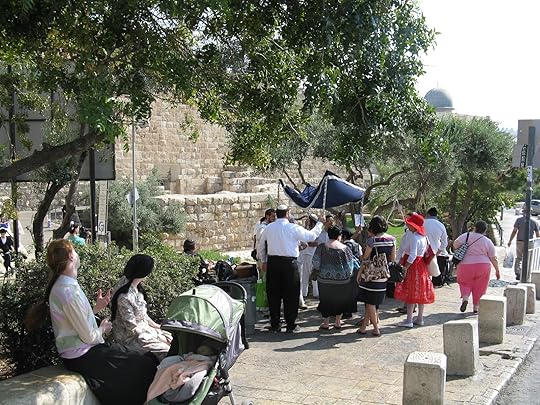 A Bar Mitzvah near the Dung GateThe Dung Gate could also be considered the trash gate because it was the most common place to dump the city’s refuse. One reason for this is that the Dung Gate was at the lowest point in Jerusalem. Beyond the gate was a steep drop-off into the Hinnom Valley. People in the city threw their trash over the cliff and down to the bottom of the valley so the people of Jerusalem would never see their trash anymore.
A Bar Mitzvah near the Dung GateThe Dung Gate could also be considered the trash gate because it was the most common place to dump the city’s refuse. One reason for this is that the Dung Gate was at the lowest point in Jerusalem. Beyond the gate was a steep drop-off into the Hinnom Valley. People in the city threw their trash over the cliff and down to the bottom of the valley so the people of Jerusalem would never see their trash anymore.
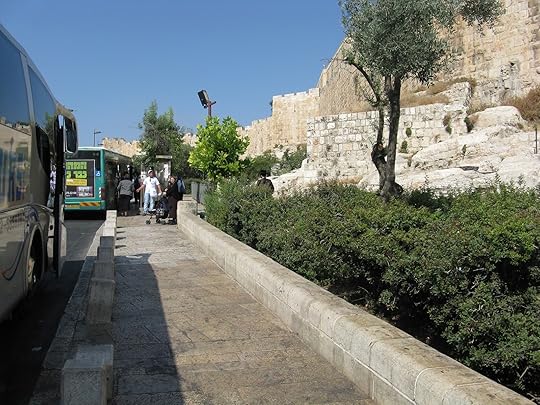 Exiting Buses near the Dung GateThe dung gate of Jerusalem received its name because a cattle market existed at this place in the past. Livestock were brought in through the gate and sold in a market. When the animals were sold, butchers were available to process the meat and tanners were available to receive the skins which were turned into leather products Dung from the cattle and chemicals from the tanners were disposed of out the gate and over the hill in Hinnom Valley.
Exiting Buses near the Dung GateThe dung gate of Jerusalem received its name because a cattle market existed at this place in the past. Livestock were brought in through the gate and sold in a market. When the animals were sold, butchers were available to process the meat and tanners were available to receive the skins which were turned into leather products Dung from the cattle and chemicals from the tanners were disposed of out the gate and over the hill in Hinnom Valley.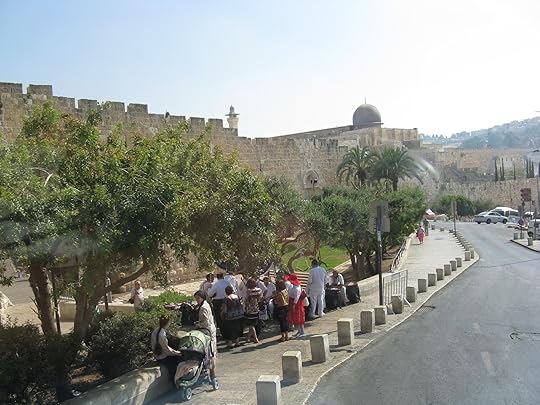 View of the Dung Gate walkway facing to the eastAcross the course of history there were actually two Dung Gates. The older gate existed below the Pool of Siloam in the days of the First and Second Temple. The other Dung Gate, that exists today, is about three-tenths of a mile uphill from the old location in the city of Jebus. Both gates were known in the time of Nehemiah, the older gate was called the Dung Gate, the upper location was known as the Valley Gate. Both gates were located in the Tyropoeon Valley, which intersects Jerusalem.
View of the Dung Gate walkway facing to the eastAcross the course of history there were actually two Dung Gates. The older gate existed below the Pool of Siloam in the days of the First and Second Temple. The other Dung Gate, that exists today, is about three-tenths of a mile uphill from the old location in the city of Jebus. Both gates were known in the time of Nehemiah, the older gate was called the Dung Gate, the upper location was known as the Valley Gate. Both gates were located in the Tyropoeon Valley, which intersects Jerusalem.
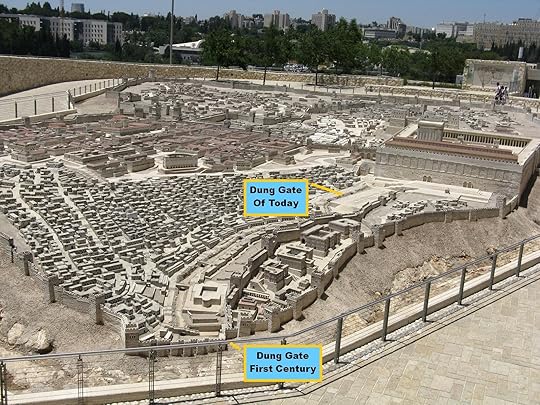 Old and New Dung Gate sitesThe Dung Gate today is an entry point for those wanting visit the Western Wall (Kotel). The gate is very busy today, and was a commercial center in antiquity. Close to the area are several archaeological sites. The Western Wall excavations are north of the Dung Gate and to the south of the gate the Israel Antiquities Authority is digging at what used to be the Giv'ati Parking Lot. They have found the home of Queen Helena of Adiabene (read more in my book - Israel: Stories for Your Journey) as well as other artifacts.
Old and New Dung Gate sitesThe Dung Gate today is an entry point for those wanting visit the Western Wall (Kotel). The gate is very busy today, and was a commercial center in antiquity. Close to the area are several archaeological sites. The Western Wall excavations are north of the Dung Gate and to the south of the gate the Israel Antiquities Authority is digging at what used to be the Giv'ati Parking Lot. They have found the home of Queen Helena of Adiabene (read more in my book - Israel: Stories for Your Journey) as well as other artifacts.
 Experience Israel through its stories
Experience Israel through its stories
I invite you to join me as I lead a group to explore the land of Israel or read my book to learn more.
 A Bar Mitzvah near the Dung GateThe Dung Gate could also be considered the trash gate because it was the most common place to dump the city’s refuse. One reason for this is that the Dung Gate was at the lowest point in Jerusalem. Beyond the gate was a steep drop-off into the Hinnom Valley. People in the city threw their trash over the cliff and down to the bottom of the valley so the people of Jerusalem would never see their trash anymore.
A Bar Mitzvah near the Dung GateThe Dung Gate could also be considered the trash gate because it was the most common place to dump the city’s refuse. One reason for this is that the Dung Gate was at the lowest point in Jerusalem. Beyond the gate was a steep drop-off into the Hinnom Valley. People in the city threw their trash over the cliff and down to the bottom of the valley so the people of Jerusalem would never see their trash anymore. Exiting Buses near the Dung GateThe dung gate of Jerusalem received its name because a cattle market existed at this place in the past. Livestock were brought in through the gate and sold in a market. When the animals were sold, butchers were available to process the meat and tanners were available to receive the skins which were turned into leather products Dung from the cattle and chemicals from the tanners were disposed of out the gate and over the hill in Hinnom Valley.
Exiting Buses near the Dung GateThe dung gate of Jerusalem received its name because a cattle market existed at this place in the past. Livestock were brought in through the gate and sold in a market. When the animals were sold, butchers were available to process the meat and tanners were available to receive the skins which were turned into leather products Dung from the cattle and chemicals from the tanners were disposed of out the gate and over the hill in Hinnom Valley. View of the Dung Gate walkway facing to the eastAcross the course of history there were actually two Dung Gates. The older gate existed below the Pool of Siloam in the days of the First and Second Temple. The other Dung Gate, that exists today, is about three-tenths of a mile uphill from the old location in the city of Jebus. Both gates were known in the time of Nehemiah, the older gate was called the Dung Gate, the upper location was known as the Valley Gate. Both gates were located in the Tyropoeon Valley, which intersects Jerusalem.
View of the Dung Gate walkway facing to the eastAcross the course of history there were actually two Dung Gates. The older gate existed below the Pool of Siloam in the days of the First and Second Temple. The other Dung Gate, that exists today, is about three-tenths of a mile uphill from the old location in the city of Jebus. Both gates were known in the time of Nehemiah, the older gate was called the Dung Gate, the upper location was known as the Valley Gate. Both gates were located in the Tyropoeon Valley, which intersects Jerusalem. Old and New Dung Gate sitesThe Dung Gate today is an entry point for those wanting visit the Western Wall (Kotel). The gate is very busy today, and was a commercial center in antiquity. Close to the area are several archaeological sites. The Western Wall excavations are north of the Dung Gate and to the south of the gate the Israel Antiquities Authority is digging at what used to be the Giv'ati Parking Lot. They have found the home of Queen Helena of Adiabene (read more in my book - Israel: Stories for Your Journey) as well as other artifacts.
Old and New Dung Gate sitesThe Dung Gate today is an entry point for those wanting visit the Western Wall (Kotel). The gate is very busy today, and was a commercial center in antiquity. Close to the area are several archaeological sites. The Western Wall excavations are north of the Dung Gate and to the south of the gate the Israel Antiquities Authority is digging at what used to be the Giv'ati Parking Lot. They have found the home of Queen Helena of Adiabene (read more in my book - Israel: Stories for Your Journey) as well as other artifacts. Experience Israel through its stories
Experience Israel through its storiesI invite you to join me as I lead a group to explore the land of Israel or read my book to learn more.
Published on February 21, 2018 03:30
February 16, 2018
The Passover Seder
The festive meal called by some Passover and by others Pesach was instituted when Moses wrote, “Tell the whole community of Israel that on the tenth day of this month each man is to take a lamb for his family.” (Exodus 12:3) Many who read this blog are familiar with the story: each family selected a lamb, prepared it for supper, and dined in a manner fully prepared to escape 430 years of slavery to Egypt. During the night after the dinner. The angel of death passed through the land of Egypt taking the lives of firstborn males who resided in homes with clean (blood-free) doorposts.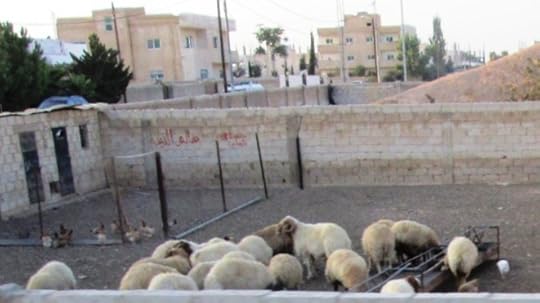 Backyard Sheep on the road in JordanFollowing mederoic events which preceded and followed the first Pesach, the meal with all of its festivities and its history changing story, has been celebrated in Jewish homes across 3,500 years of history. The celebration of Passover has grown from a simple meal shared by a tribe of desert wanderers to an event acclaimed and esteemed around the world. Participation in Passover festivities is popular today. According to Pew Research 70% of Jews participate in the Seder dinner. Passover expanded beyond people of Jewish descent and today is honored in a truncated form by followers of Jesus.
Backyard Sheep on the road in JordanFollowing mederoic events which preceded and followed the first Pesach, the meal with all of its festivities and its history changing story, has been celebrated in Jewish homes across 3,500 years of history. The celebration of Passover has grown from a simple meal shared by a tribe of desert wanderers to an event acclaimed and esteemed around the world. Participation in Passover festivities is popular today. According to Pew Research 70% of Jews participate in the Seder dinner. Passover expanded beyond people of Jewish descent and today is honored in a truncated form by followers of Jesus.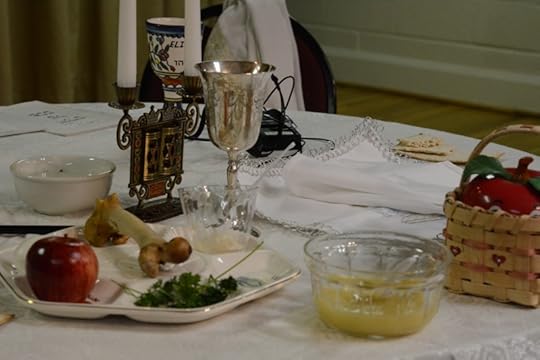 Preparation for the Passover SederThe power of the Passover was inbred in the fabric of the feast from its very beginning. Moses wrote, “On that day tell your son, ‘I do this because of what the Lord did for me when I came out of Egypt.’ This observance will be for you like a sign on your hand and a reminder on your forehead that this law of the Lord is to be on your lips.” (Exodus 13:8-9) Passover is a family celebration. It is celebrated in the home and led by the head of the household. In today’s Jewish world there is a book called the Haggadah that helps the untrained leader to guide his family through the plan for the evening.
Preparation for the Passover SederThe power of the Passover was inbred in the fabric of the feast from its very beginning. Moses wrote, “On that day tell your son, ‘I do this because of what the Lord did for me when I came out of Egypt.’ This observance will be for you like a sign on your hand and a reminder on your forehead that this law of the Lord is to be on your lips.” (Exodus 13:8-9) Passover is a family celebration. It is celebrated in the home and led by the head of the household. In today’s Jewish world there is a book called the Haggadah that helps the untrained leader to guide his family through the plan for the evening.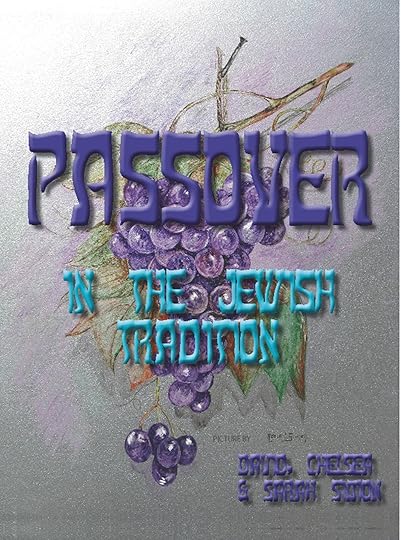 Explanation of each part of the Passover SederThrough history activities have been included in the Seder to hold the interest of children. These include tasting various foods, four questions which are asked by the eldest child, a lesson on four sons, the singing of Dayenu, the finding of the Matzah and a visit by Elijah. The activities of the evening are presented in a laid back style with lots of laughter and and stories produced by both the ancient Rabbis and and members of the household who retell memorable events from past holidays.
Explanation of each part of the Passover SederThrough history activities have been included in the Seder to hold the interest of children. These include tasting various foods, four questions which are asked by the eldest child, a lesson on four sons, the singing of Dayenu, the finding of the Matzah and a visit by Elijah. The activities of the evening are presented in a laid back style with lots of laughter and and stories produced by both the ancient Rabbis and and members of the household who retell memorable events from past holidays.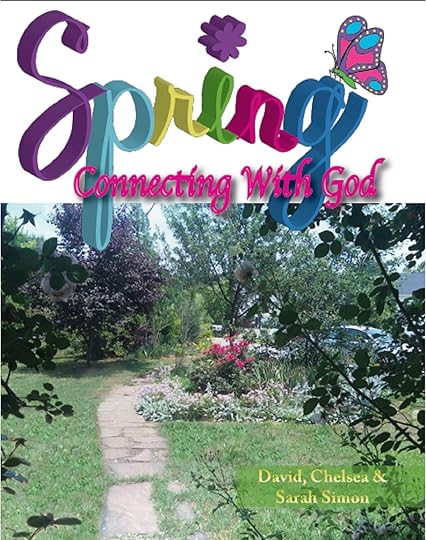 Book telling how Passover is about our Relationship with GodPassover is a beloved event in Jewish families because it connects ancient religious tradition with today’s family. Moses said it was “like a sign on your hand and a reminder on your forehead,” bringing to mind his words of Deuteronomy 6, “Talk about them when you sit at home and when you walk along the road, when you lie down and when you get up.” (Deut 6:4-9) Passover is to be made as purposeful, meaningful and fun as the tradition of bedtime stories when children are young.
Book telling how Passover is about our Relationship with GodPassover is a beloved event in Jewish families because it connects ancient religious tradition with today’s family. Moses said it was “like a sign on your hand and a reminder on your forehead,” bringing to mind his words of Deuteronomy 6, “Talk about them when you sit at home and when you walk along the road, when you lie down and when you get up.” (Deut 6:4-9) Passover is to be made as purposeful, meaningful and fun as the tradition of bedtime stories when children are young.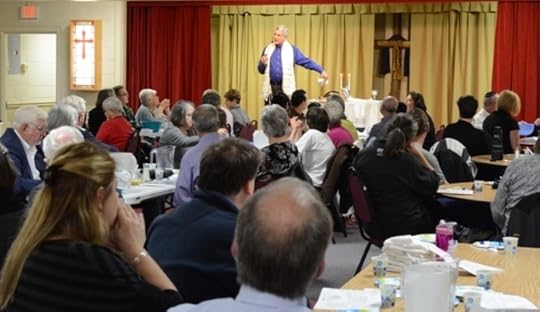 Large group celebrating the PassoverReligious events like Passover, filled with meaning, fun, and inclusive of children, are an important element that helps faith communities to grow and continue from generation to generation. One of the things that brings me joy in life is to lead and see others lead Passover Seders that tell the stories of faith in a fun way in order to instruct the next generation. If you live in central North Carolina or in South Carolina and would enjoy a Passover Seder in your church, please contact me.
Large group celebrating the PassoverReligious events like Passover, filled with meaning, fun, and inclusive of children, are an important element that helps faith communities to grow and continue from generation to generation. One of the things that brings me joy in life is to lead and see others lead Passover Seders that tell the stories of faith in a fun way in order to instruct the next generation. If you live in central North Carolina or in South Carolina and would enjoy a Passover Seder in your church, please contact me.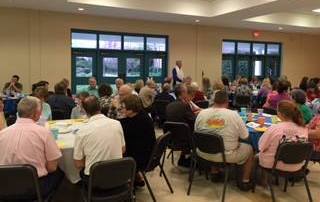 Large group celebrating the PassoverIf you would like to know how to lead a Passover Seder for your group, please take a look at my book for leaders: A Christian Passover in the Jewish Tradition. This book contains preparations for the Seder, recipes, leader instructions, the words to be spoken and leader instructions. It also has a large section explaining every part of the Passover.
Large group celebrating the PassoverIf you would like to know how to lead a Passover Seder for your group, please take a look at my book for leaders: A Christian Passover in the Jewish Tradition. This book contains preparations for the Seder, recipes, leader instructions, the words to be spoken and leader instructions. It also has a large section explaining every part of the Passover.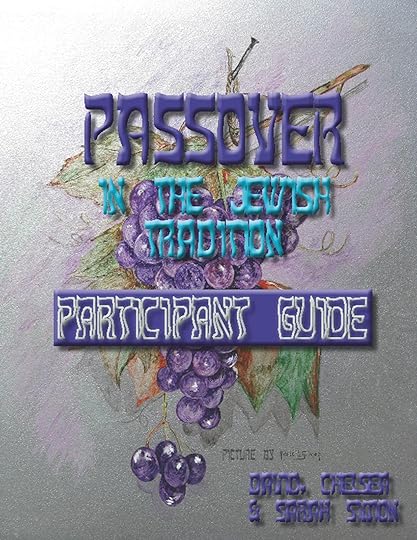 Kindle Passover Seder
Kindle Passover Seder
I have also put together a kindle book that contains the service (but not the leader guide or commentary) for participants. The participant guide has been revised this year and is available for under $1 on Amazon.com.
 Backyard Sheep on the road in JordanFollowing mederoic events which preceded and followed the first Pesach, the meal with all of its festivities and its history changing story, has been celebrated in Jewish homes across 3,500 years of history. The celebration of Passover has grown from a simple meal shared by a tribe of desert wanderers to an event acclaimed and esteemed around the world. Participation in Passover festivities is popular today. According to Pew Research 70% of Jews participate in the Seder dinner. Passover expanded beyond people of Jewish descent and today is honored in a truncated form by followers of Jesus.
Backyard Sheep on the road in JordanFollowing mederoic events which preceded and followed the first Pesach, the meal with all of its festivities and its history changing story, has been celebrated in Jewish homes across 3,500 years of history. The celebration of Passover has grown from a simple meal shared by a tribe of desert wanderers to an event acclaimed and esteemed around the world. Participation in Passover festivities is popular today. According to Pew Research 70% of Jews participate in the Seder dinner. Passover expanded beyond people of Jewish descent and today is honored in a truncated form by followers of Jesus. Preparation for the Passover SederThe power of the Passover was inbred in the fabric of the feast from its very beginning. Moses wrote, “On that day tell your son, ‘I do this because of what the Lord did for me when I came out of Egypt.’ This observance will be for you like a sign on your hand and a reminder on your forehead that this law of the Lord is to be on your lips.” (Exodus 13:8-9) Passover is a family celebration. It is celebrated in the home and led by the head of the household. In today’s Jewish world there is a book called the Haggadah that helps the untrained leader to guide his family through the plan for the evening.
Preparation for the Passover SederThe power of the Passover was inbred in the fabric of the feast from its very beginning. Moses wrote, “On that day tell your son, ‘I do this because of what the Lord did for me when I came out of Egypt.’ This observance will be for you like a sign on your hand and a reminder on your forehead that this law of the Lord is to be on your lips.” (Exodus 13:8-9) Passover is a family celebration. It is celebrated in the home and led by the head of the household. In today’s Jewish world there is a book called the Haggadah that helps the untrained leader to guide his family through the plan for the evening. Explanation of each part of the Passover SederThrough history activities have been included in the Seder to hold the interest of children. These include tasting various foods, four questions which are asked by the eldest child, a lesson on four sons, the singing of Dayenu, the finding of the Matzah and a visit by Elijah. The activities of the evening are presented in a laid back style with lots of laughter and and stories produced by both the ancient Rabbis and and members of the household who retell memorable events from past holidays.
Explanation of each part of the Passover SederThrough history activities have been included in the Seder to hold the interest of children. These include tasting various foods, four questions which are asked by the eldest child, a lesson on four sons, the singing of Dayenu, the finding of the Matzah and a visit by Elijah. The activities of the evening are presented in a laid back style with lots of laughter and and stories produced by both the ancient Rabbis and and members of the household who retell memorable events from past holidays. Book telling how Passover is about our Relationship with GodPassover is a beloved event in Jewish families because it connects ancient religious tradition with today’s family. Moses said it was “like a sign on your hand and a reminder on your forehead,” bringing to mind his words of Deuteronomy 6, “Talk about them when you sit at home and when you walk along the road, when you lie down and when you get up.” (Deut 6:4-9) Passover is to be made as purposeful, meaningful and fun as the tradition of bedtime stories when children are young.
Book telling how Passover is about our Relationship with GodPassover is a beloved event in Jewish families because it connects ancient religious tradition with today’s family. Moses said it was “like a sign on your hand and a reminder on your forehead,” bringing to mind his words of Deuteronomy 6, “Talk about them when you sit at home and when you walk along the road, when you lie down and when you get up.” (Deut 6:4-9) Passover is to be made as purposeful, meaningful and fun as the tradition of bedtime stories when children are young. Large group celebrating the PassoverReligious events like Passover, filled with meaning, fun, and inclusive of children, are an important element that helps faith communities to grow and continue from generation to generation. One of the things that brings me joy in life is to lead and see others lead Passover Seders that tell the stories of faith in a fun way in order to instruct the next generation. If you live in central North Carolina or in South Carolina and would enjoy a Passover Seder in your church, please contact me.
Large group celebrating the PassoverReligious events like Passover, filled with meaning, fun, and inclusive of children, are an important element that helps faith communities to grow and continue from generation to generation. One of the things that brings me joy in life is to lead and see others lead Passover Seders that tell the stories of faith in a fun way in order to instruct the next generation. If you live in central North Carolina or in South Carolina and would enjoy a Passover Seder in your church, please contact me. Large group celebrating the PassoverIf you would like to know how to lead a Passover Seder for your group, please take a look at my book for leaders: A Christian Passover in the Jewish Tradition. This book contains preparations for the Seder, recipes, leader instructions, the words to be spoken and leader instructions. It also has a large section explaining every part of the Passover.
Large group celebrating the PassoverIf you would like to know how to lead a Passover Seder for your group, please take a look at my book for leaders: A Christian Passover in the Jewish Tradition. This book contains preparations for the Seder, recipes, leader instructions, the words to be spoken and leader instructions. It also has a large section explaining every part of the Passover. Kindle Passover Seder
Kindle Passover SederI have also put together a kindle book that contains the service (but not the leader guide or commentary) for participants. The participant guide has been revised this year and is available for under $1 on Amazon.com.
Published on February 16, 2018 03:30
Learning to Love God
I am a Christian Educator. My life’s work was to help people learn and live the words of the Bible. I prepared lessons and trained teachers to lead classes for all ages, from the youngest babies to the most elderly adults. Along the way I substituted, taught and worked alongside the teachers in each age group. Through my life’s work I fell in love with people and the end result of Bible lessons being incorporated into their lives.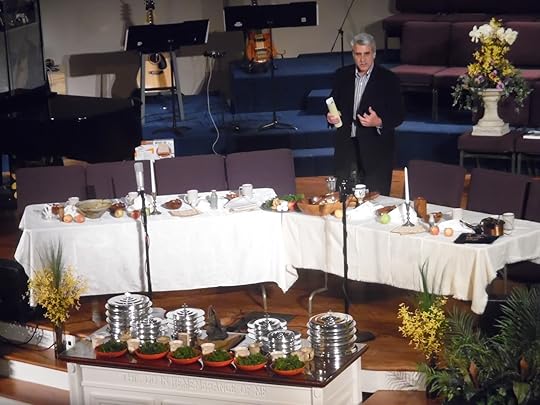 Leading a Passover Seder at Fairview Baptist Church, StatesvilleFrom a very young age I learned to listen to the words of scripture and love it’s stories. This did not happen in a church, for I did not go to church, I was raised in a Jewish home. My most memorable times of Bible learning occurred in the home. When I was young my mother would read to me from a book of Bible stories. Our family also celebrated the Jewish holidays and learned the traditions that go with each event.
Leading a Passover Seder at Fairview Baptist Church, StatesvilleFrom a very young age I learned to listen to the words of scripture and love it’s stories. This did not happen in a church, for I did not go to church, I was raised in a Jewish home. My most memorable times of Bible learning occurred in the home. When I was young my mother would read to me from a book of Bible stories. Our family also celebrated the Jewish holidays and learned the traditions that go with each event.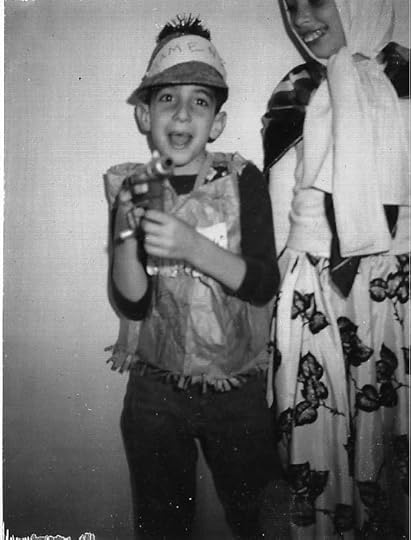 Dressed up for our Purim CelebrationThis month we will celebrate the festival called Purim. When I was young, my family would go to the Synagogue, where we would hear stories from the Megillah, the book of Esther. We dressed in costumes, played carnival type games, ate food (including hamantaschen), and heard a presentation from the book of Esther every half hour. These recitations could be story reading, puppet plays or dramas. Each telling was “child friendly,” and enabled me to remember the reason for the event.
Dressed up for our Purim CelebrationThis month we will celebrate the festival called Purim. When I was young, my family would go to the Synagogue, where we would hear stories from the Megillah, the book of Esther. We dressed in costumes, played carnival type games, ate food (including hamantaschen), and heard a presentation from the book of Esther every half hour. These recitations could be story reading, puppet plays or dramas. Each telling was “child friendly,” and enabled me to remember the reason for the event.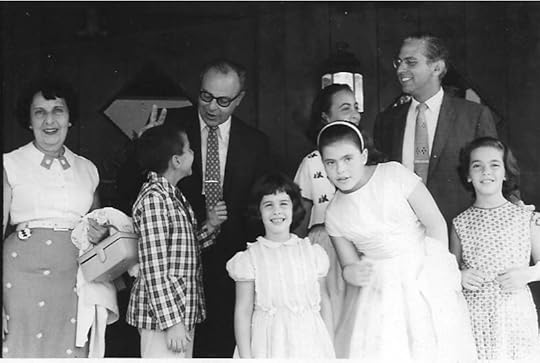 My Passover FamilyNext month we will celebrate Passover (or Pesach), the Jewish feast which remembers how God enabled my people to escape slavery in Egypt. During this festival we would go to Uncle Stuart and Aunt Betty’s home, for Uncle Stuart was the eldest son in the family. I would see my grandmother and spend the afternoon playing with my cousins. We were family.
My Passover FamilyNext month we will celebrate Passover (or Pesach), the Jewish feast which remembers how God enabled my people to escape slavery in Egypt. During this festival we would go to Uncle Stuart and Aunt Betty’s home, for Uncle Stuart was the eldest son in the family. I would see my grandmother and spend the afternoon playing with my cousins. We were family.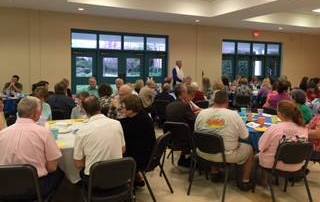 Passover at Salem Baptist Church in Apex, NCAt the appointed time on Passover eve, we would all sit down at the long table to enjoy a feast. But before we ate, we participated in and heard the story of the Exodus from Egypt. The memorable words repeated year after year from the Haggadah for the American Family. My Uncle Stuart would lead and each of us would read our parts, as broken out in the book. After much more than a decade of following this tradition, some of the lines we read are etched on my memory from simple repetition.
Passover at Salem Baptist Church in Apex, NCAt the appointed time on Passover eve, we would all sit down at the long table to enjoy a feast. But before we ate, we participated in and heard the story of the Exodus from Egypt. The memorable words repeated year after year from the Haggadah for the American Family. My Uncle Stuart would lead and each of us would read our parts, as broken out in the book. After much more than a decade of following this tradition, some of the lines we read are etched on my memory from simple repetition.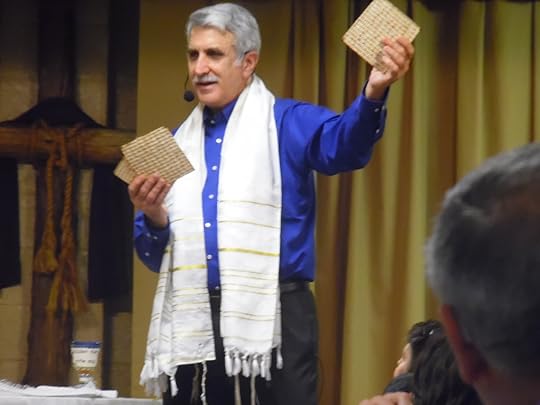 Breaking Matzoh at Central Methodist Church, Mooresville, NCDuring the evening we would spend at least an hour saying the blessings, reading the scripture, tasting the foods (like karpas, matzoh, morror and charosis), singing the songs, and reciting the story. A huge feast would come near the end of the book, once the story was told and the plagues of Egypt recited.
Breaking Matzoh at Central Methodist Church, Mooresville, NCDuring the evening we would spend at least an hour saying the blessings, reading the scripture, tasting the foods (like karpas, matzoh, morror and charosis), singing the songs, and reciting the story. A huge feast would come near the end of the book, once the story was told and the plagues of Egypt recited.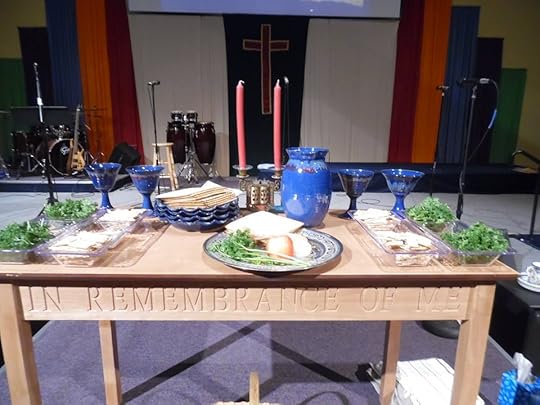 A Passover lesson at Lighthouse Church, Mooresville, NC My Uncle had a fantastic sense of humor, and made our visits to his home fun. Many stories could be told about what happened at our Passover table, but to recite them would get us off topic. The point is, my religious training was a family event, supported by the Synagogue. My family did a good job, and when my children were born I continued the tradition of sharing the story of the Bible through fun festivals and events so they could learn to love my God and my faith.
A Passover lesson at Lighthouse Church, Mooresville, NC My Uncle had a fantastic sense of humor, and made our visits to his home fun. Many stories could be told about what happened at our Passover table, but to recite them would get us off topic. The point is, my religious training was a family event, supported by the Synagogue. My family did a good job, and when my children were born I continued the tradition of sharing the story of the Bible through fun festivals and events so they could learn to love my God and my faith.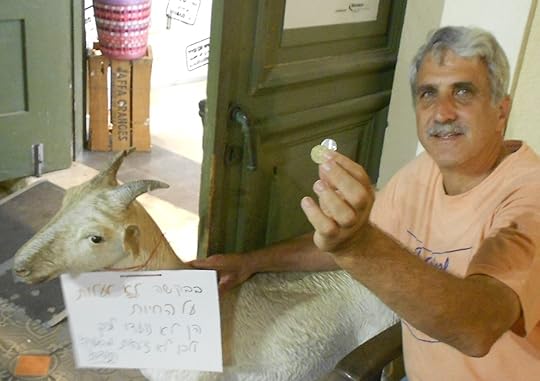 Buying a goat in Israel for two zuzimToday, even as my children are grown, I continue to share the Jewish festivals with Christians across the country. I have taken time to study the holidays to see how they were celebrated during the first century in Israel. Jesus, himself, with his parents, participated in all of the Jewish holidays. There are many references to him going to Jerusalem to participate in the Passover, the Feast of Tabernacles and Chanukah. To miss the connection is to erase a portion of the New Testament.
Buying a goat in Israel for two zuzimToday, even as my children are grown, I continue to share the Jewish festivals with Christians across the country. I have taken time to study the holidays to see how they were celebrated during the first century in Israel. Jesus, himself, with his parents, participated in all of the Jewish holidays. There are many references to him going to Jerusalem to participate in the Passover, the Feast of Tabernacles and Chanukah. To miss the connection is to erase a portion of the New Testament.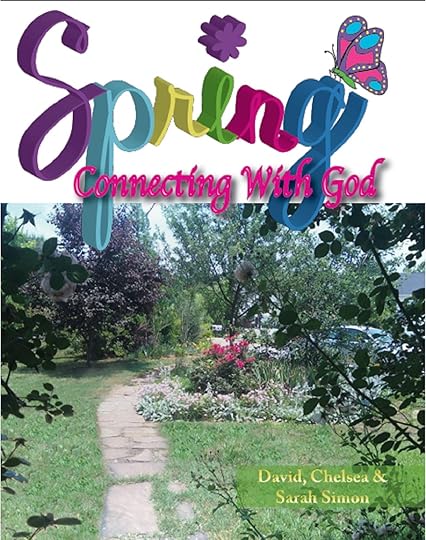 My book celebrating Passover as a Relationship with GodTo miss sharing the faith with our children in the same manner as Jesus’ parents shared the Jewish traditions with their children is to ignore the teachings of the Bible handed down since the days of Moses.
My book celebrating Passover as a Relationship with GodTo miss sharing the faith with our children in the same manner as Jesus’ parents shared the Jewish traditions with their children is to ignore the teachings of the Bible handed down since the days of Moses.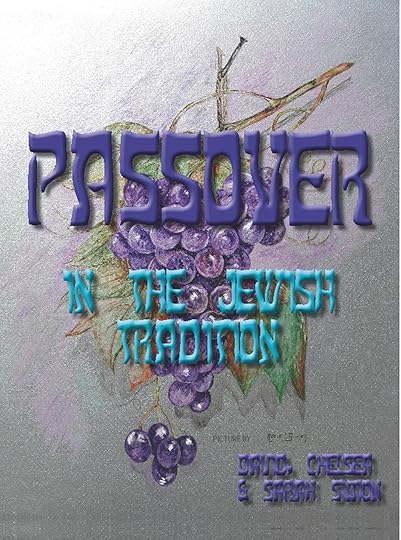 A Passover Haggadah with complete explanations and leader hintsMy daughters and I have written several books (Spring: Connecting with God, A Christian Passover in the Jewish Tradition, two Kindle Haggadahs, and Advent Journeys) to help Christians understand the Jewish and early Christian traditions of Passover. We lead these services in churches to help people understand these traditions within their context, hoping the next generation will grow up with the same love of God I have enjoyed through life. I guide church Seder services for any who desire to know more. For more information, contact me through my e-mail address.
A Passover Haggadah with complete explanations and leader hintsMy daughters and I have written several books (Spring: Connecting with God, A Christian Passover in the Jewish Tradition, two Kindle Haggadahs, and Advent Journeys) to help Christians understand the Jewish and early Christian traditions of Passover. We lead these services in churches to help people understand these traditions within their context, hoping the next generation will grow up with the same love of God I have enjoyed through life. I guide church Seder services for any who desire to know more. For more information, contact me through my e-mail address.
 Leading a Passover Seder at Fairview Baptist Church, StatesvilleFrom a very young age I learned to listen to the words of scripture and love it’s stories. This did not happen in a church, for I did not go to church, I was raised in a Jewish home. My most memorable times of Bible learning occurred in the home. When I was young my mother would read to me from a book of Bible stories. Our family also celebrated the Jewish holidays and learned the traditions that go with each event.
Leading a Passover Seder at Fairview Baptist Church, StatesvilleFrom a very young age I learned to listen to the words of scripture and love it’s stories. This did not happen in a church, for I did not go to church, I was raised in a Jewish home. My most memorable times of Bible learning occurred in the home. When I was young my mother would read to me from a book of Bible stories. Our family also celebrated the Jewish holidays and learned the traditions that go with each event. Dressed up for our Purim CelebrationThis month we will celebrate the festival called Purim. When I was young, my family would go to the Synagogue, where we would hear stories from the Megillah, the book of Esther. We dressed in costumes, played carnival type games, ate food (including hamantaschen), and heard a presentation from the book of Esther every half hour. These recitations could be story reading, puppet plays or dramas. Each telling was “child friendly,” and enabled me to remember the reason for the event.
Dressed up for our Purim CelebrationThis month we will celebrate the festival called Purim. When I was young, my family would go to the Synagogue, where we would hear stories from the Megillah, the book of Esther. We dressed in costumes, played carnival type games, ate food (including hamantaschen), and heard a presentation from the book of Esther every half hour. These recitations could be story reading, puppet plays or dramas. Each telling was “child friendly,” and enabled me to remember the reason for the event. My Passover FamilyNext month we will celebrate Passover (or Pesach), the Jewish feast which remembers how God enabled my people to escape slavery in Egypt. During this festival we would go to Uncle Stuart and Aunt Betty’s home, for Uncle Stuart was the eldest son in the family. I would see my grandmother and spend the afternoon playing with my cousins. We were family.
My Passover FamilyNext month we will celebrate Passover (or Pesach), the Jewish feast which remembers how God enabled my people to escape slavery in Egypt. During this festival we would go to Uncle Stuart and Aunt Betty’s home, for Uncle Stuart was the eldest son in the family. I would see my grandmother and spend the afternoon playing with my cousins. We were family. Passover at Salem Baptist Church in Apex, NCAt the appointed time on Passover eve, we would all sit down at the long table to enjoy a feast. But before we ate, we participated in and heard the story of the Exodus from Egypt. The memorable words repeated year after year from the Haggadah for the American Family. My Uncle Stuart would lead and each of us would read our parts, as broken out in the book. After much more than a decade of following this tradition, some of the lines we read are etched on my memory from simple repetition.
Passover at Salem Baptist Church in Apex, NCAt the appointed time on Passover eve, we would all sit down at the long table to enjoy a feast. But before we ate, we participated in and heard the story of the Exodus from Egypt. The memorable words repeated year after year from the Haggadah for the American Family. My Uncle Stuart would lead and each of us would read our parts, as broken out in the book. After much more than a decade of following this tradition, some of the lines we read are etched on my memory from simple repetition. Breaking Matzoh at Central Methodist Church, Mooresville, NCDuring the evening we would spend at least an hour saying the blessings, reading the scripture, tasting the foods (like karpas, matzoh, morror and charosis), singing the songs, and reciting the story. A huge feast would come near the end of the book, once the story was told and the plagues of Egypt recited.
Breaking Matzoh at Central Methodist Church, Mooresville, NCDuring the evening we would spend at least an hour saying the blessings, reading the scripture, tasting the foods (like karpas, matzoh, morror and charosis), singing the songs, and reciting the story. A huge feast would come near the end of the book, once the story was told and the plagues of Egypt recited. A Passover lesson at Lighthouse Church, Mooresville, NC My Uncle had a fantastic sense of humor, and made our visits to his home fun. Many stories could be told about what happened at our Passover table, but to recite them would get us off topic. The point is, my religious training was a family event, supported by the Synagogue. My family did a good job, and when my children were born I continued the tradition of sharing the story of the Bible through fun festivals and events so they could learn to love my God and my faith.
A Passover lesson at Lighthouse Church, Mooresville, NC My Uncle had a fantastic sense of humor, and made our visits to his home fun. Many stories could be told about what happened at our Passover table, but to recite them would get us off topic. The point is, my religious training was a family event, supported by the Synagogue. My family did a good job, and when my children were born I continued the tradition of sharing the story of the Bible through fun festivals and events so they could learn to love my God and my faith. Buying a goat in Israel for two zuzimToday, even as my children are grown, I continue to share the Jewish festivals with Christians across the country. I have taken time to study the holidays to see how they were celebrated during the first century in Israel. Jesus, himself, with his parents, participated in all of the Jewish holidays. There are many references to him going to Jerusalem to participate in the Passover, the Feast of Tabernacles and Chanukah. To miss the connection is to erase a portion of the New Testament.
Buying a goat in Israel for two zuzimToday, even as my children are grown, I continue to share the Jewish festivals with Christians across the country. I have taken time to study the holidays to see how they were celebrated during the first century in Israel. Jesus, himself, with his parents, participated in all of the Jewish holidays. There are many references to him going to Jerusalem to participate in the Passover, the Feast of Tabernacles and Chanukah. To miss the connection is to erase a portion of the New Testament. My book celebrating Passover as a Relationship with GodTo miss sharing the faith with our children in the same manner as Jesus’ parents shared the Jewish traditions with their children is to ignore the teachings of the Bible handed down since the days of Moses.
My book celebrating Passover as a Relationship with GodTo miss sharing the faith with our children in the same manner as Jesus’ parents shared the Jewish traditions with their children is to ignore the teachings of the Bible handed down since the days of Moses. A Passover Haggadah with complete explanations and leader hintsMy daughters and I have written several books (Spring: Connecting with God, A Christian Passover in the Jewish Tradition, two Kindle Haggadahs, and Advent Journeys) to help Christians understand the Jewish and early Christian traditions of Passover. We lead these services in churches to help people understand these traditions within their context, hoping the next generation will grow up with the same love of God I have enjoyed through life. I guide church Seder services for any who desire to know more. For more information, contact me through my e-mail address.
A Passover Haggadah with complete explanations and leader hintsMy daughters and I have written several books (Spring: Connecting with God, A Christian Passover in the Jewish Tradition, two Kindle Haggadahs, and Advent Journeys) to help Christians understand the Jewish and early Christian traditions of Passover. We lead these services in churches to help people understand these traditions within their context, hoping the next generation will grow up with the same love of God I have enjoyed through life. I guide church Seder services for any who desire to know more. For more information, contact me through my e-mail address.
Published on February 16, 2018 03:30



